9 ° 26.561N Nargana Guna Yala
78 ° 35.175 W

25 February, 2017
– “It was a crazy adventure coming from Panama City to Filizi in Guna Yala! But I was so tired, that the adrenaline helped me. The nature on the mountains of Panama was wonderful. When the jeep’s engine broke down in the jungle, it was still early and I was not disappointed. But when we got the flat tire at the border, I thought I wouldn’t make it to Filizi today. In the end it all went and I even got a good seat in the boat, although I got in so late. 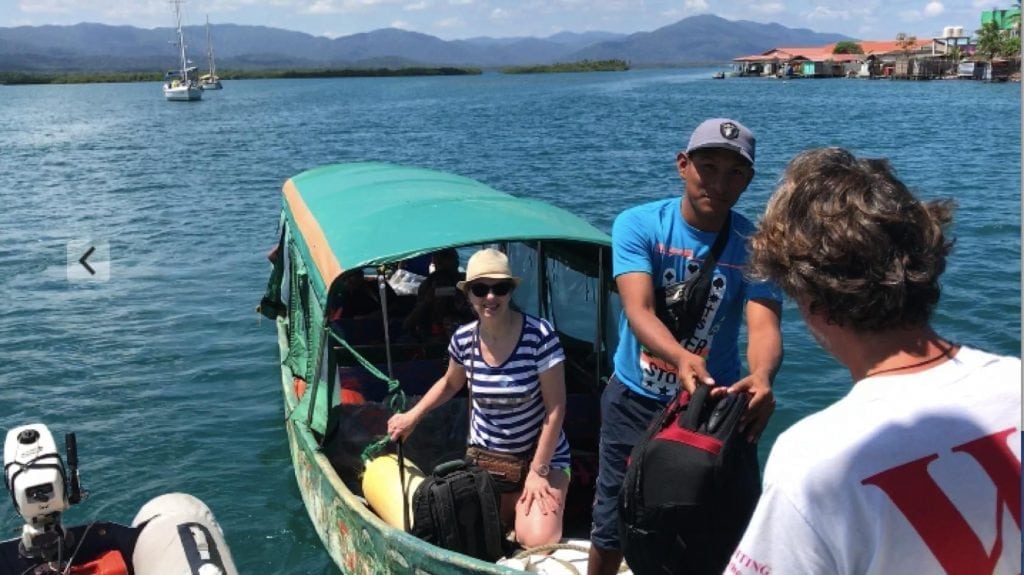 Once in the boat, I heard everyone saying “con plastico, con plastico”, but I didn’t have a clue what they were talking about. But, when we got off and the boat began speeding up, they all wrapped themselves in plastic! Some wore plastic garbage bags, others waterproof tablecloth and those who no plastic cover were soaked from the sea spray. Con plastico!” Vasso say laughing heartily. We carry her luggage in the aft cabin.
Once in the boat, I heard everyone saying “con plastico, con plastico”, but I didn’t have a clue what they were talking about. But, when we got off and the boat began speeding up, they all wrapped themselves in plastic! Some wore plastic garbage bags, others waterproof tablecloth and those who no plastic cover were soaked from the sea spray. Con plastico!” Vasso say laughing heartily. We carry her luggage in the aft cabin.
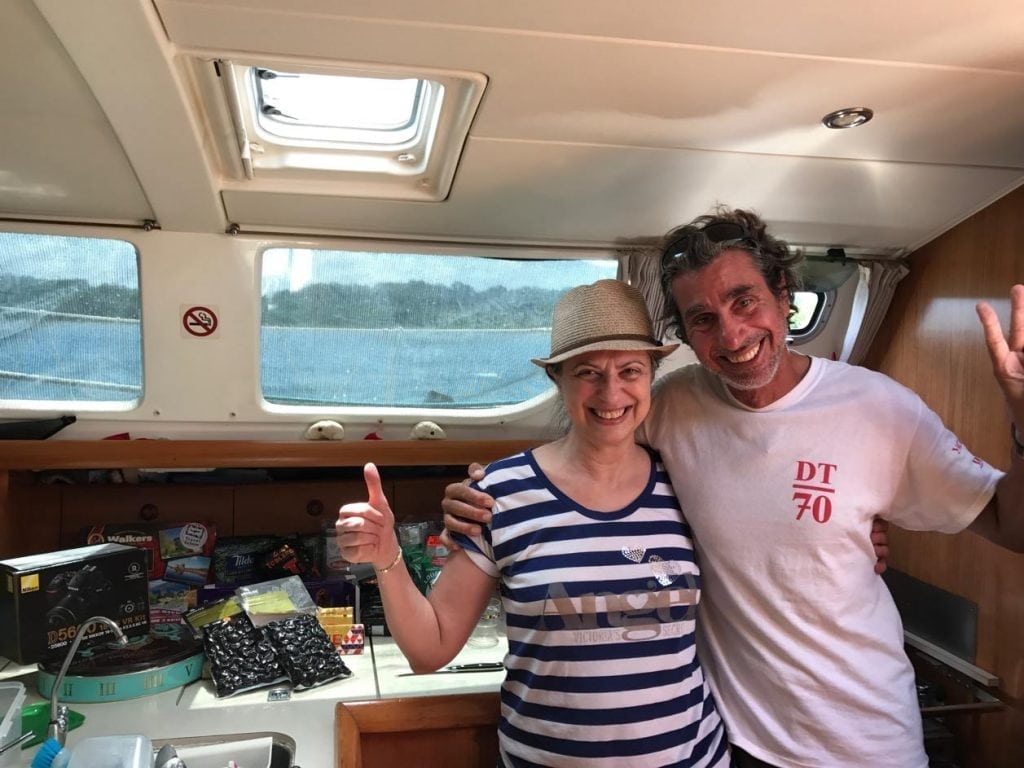
– “Let this suitcase here, I have a few things for you” She opens the suitcase: Greek coffee , Kalamata olives, chocolates … Vasso saved us, once more.
12.00 We are running late, the celebration in Isla Tigre is probably finished by now but we decide to go anyway. We learned about Tigre from Giancarlo, a nice and bright young fisherman who lives on Orduptarboat in West Coco Bandero. Tigre is off the beaten track, and tourists do not know it. We are leaving Nargana without further delay.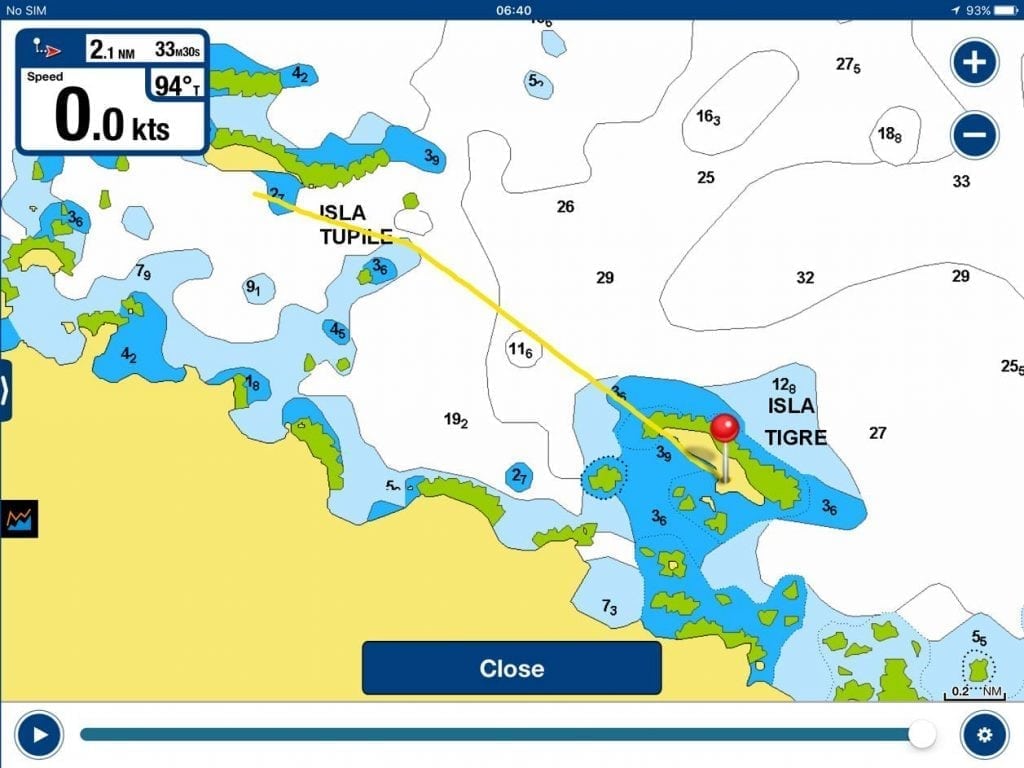
(Map: green = reefs, yellow = land)
There is no easy route here in Guna Yala, shallow reefs are lurking all around. Captain Yorgos is in full concentration, checking the Bauhaus map, the plotter, the Navionics maps on the ipad, and comparing the GPS Position on the map with the sonar. We are trusting only our eyes and the boat’s instruments. Thankfully, at this hour the sun is at its zenith and it’s easier to see the reefs. Polarized sunglasses help a lot, too. Some areas are like puzzles though, and it is difficult to tell where the safe passage is. At such a point, we coincidentally met a local cargo shuttle boat and Yorgos followed it. Lucky timing! We sailed very close next to a dreamy island.
- “How much beauty! I ‘d love to come here someday …”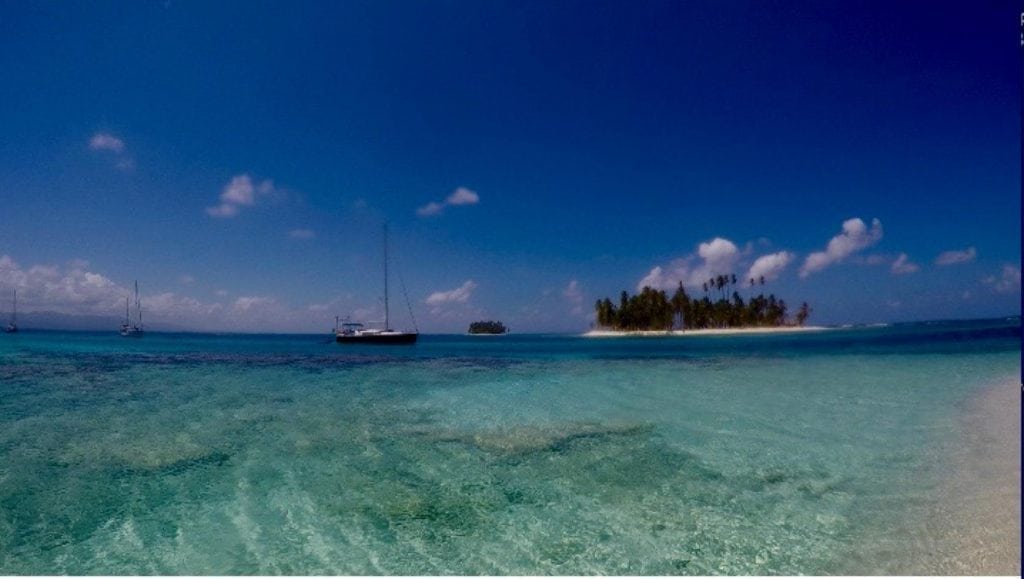
Isla Tigre (Digir) 9 ° 26.018 N 78 ° 31.588 W
We arrive at Tigre from the west, finding four sailing boats already moored. Captain choose the point and we dropped the anchor at six meters depth on sand. I let forty meters of anchor chain and put the special hook in it.
– “Ready!” I cry. The captain puts the reverse gear and slowly adds revs. We watch the chain stretching. Filizi is motionless, the anchor must be safely in the sand.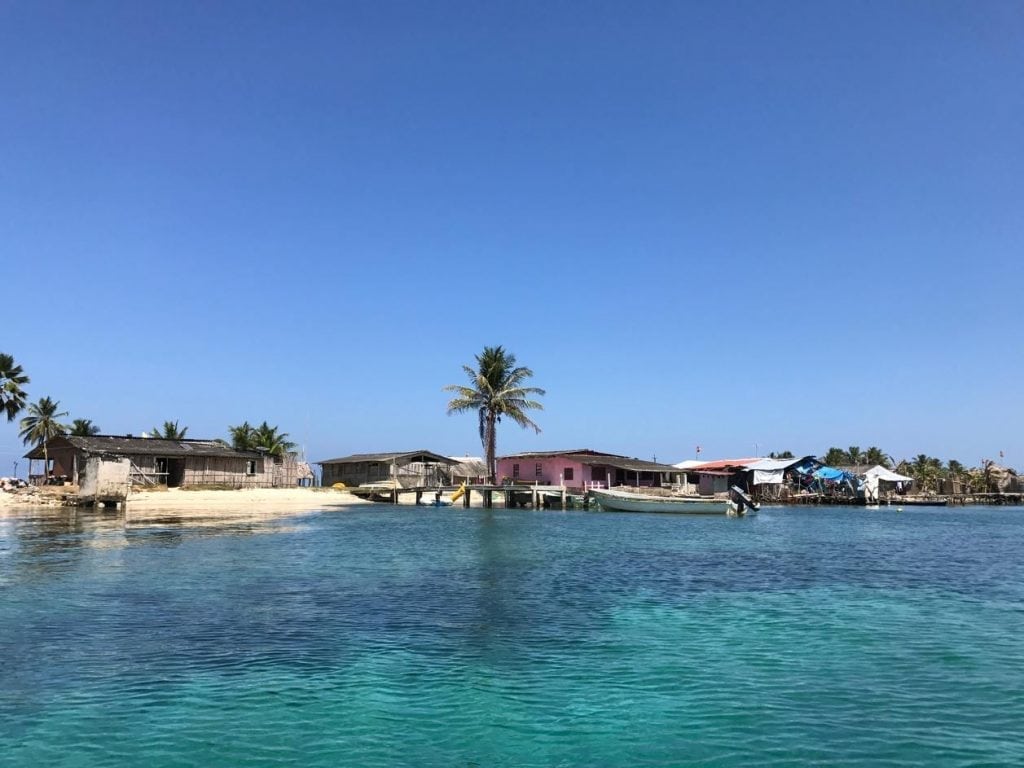
-“We are on concrete!” I yell again and make a thumb up, our code that anchor worked well. To our right, east, surrounded by emerald water and white sand, stands the serene little island with it’s poor huts. At the north end of the island the waves brake on a coral reef, that is forming bow westward. With the reef protecting it, a bank of sand goes deep into the sea , creating a natural shallow pool. In its turquoise waters many kids are swimming and playing. Their laughter is the perfect sound of summer. We all agree to have a quick swim, eat and visit the island.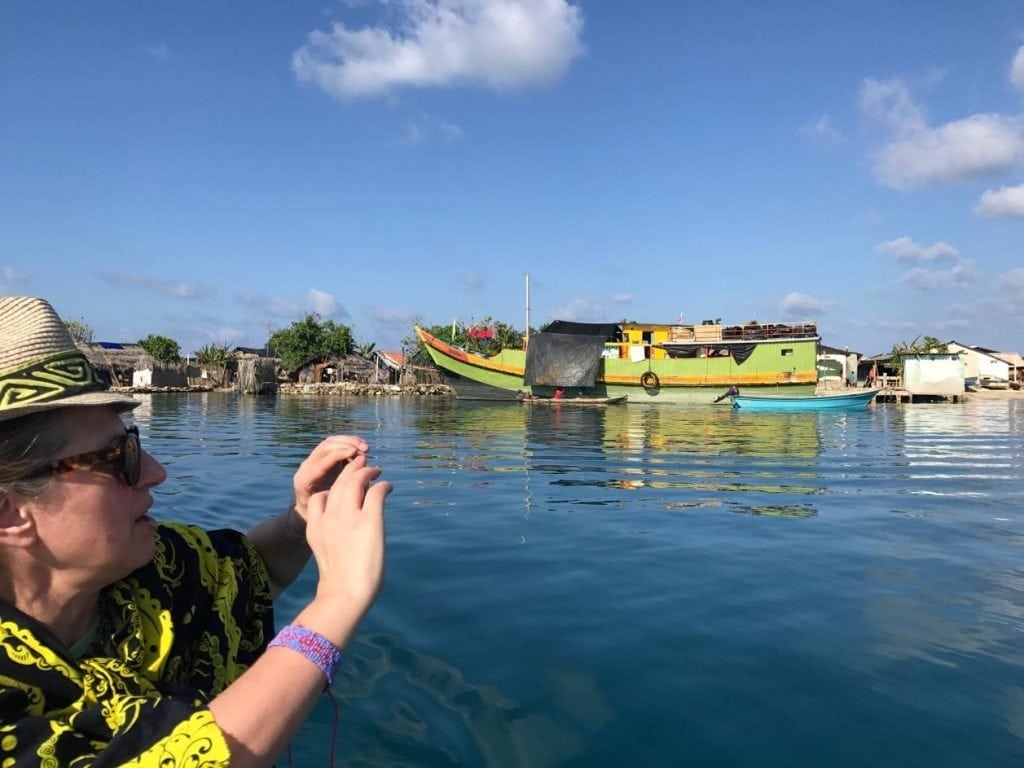
Thirty meters behind our stern the calm sea is foaming over a second reef.
– “I feel a little uneasy, with this danger behind us …” I say to Yorgos.
– “Me too, but don’t worry. The anchor is OK. I’ll dive to checkit now” Yorgos says , he takes his mask and dives. This is always his first job once anchored. I turn off the navigation instruments and bring beach towels for us all . Vasso is ready, swim suits on and googles in hand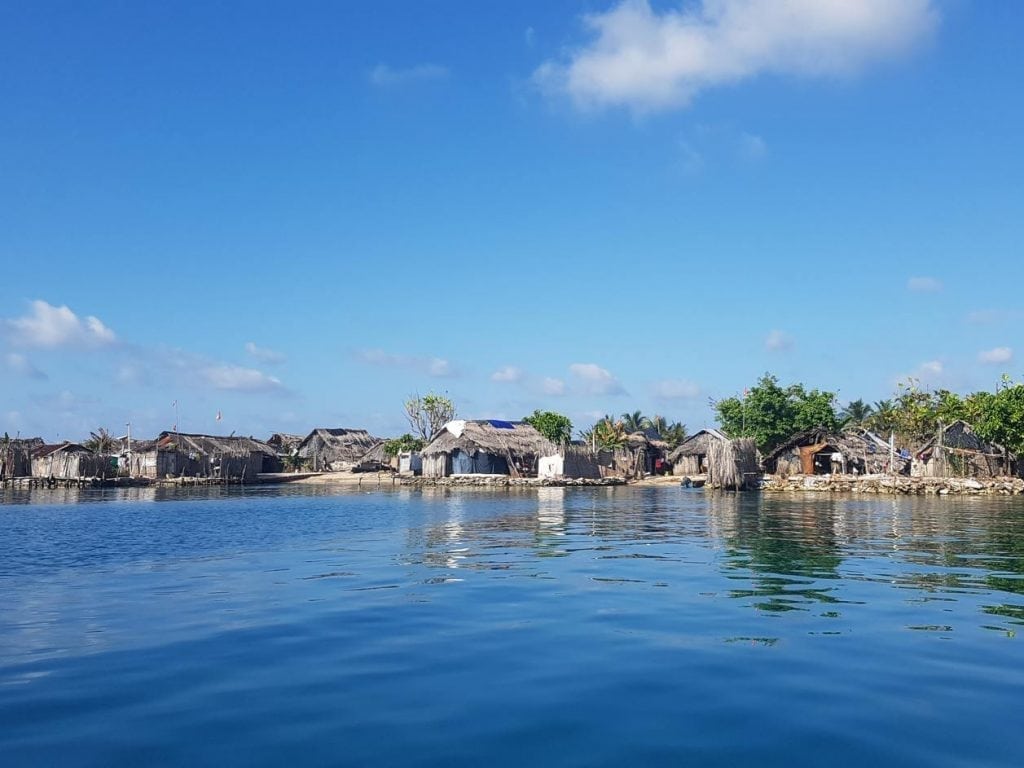
– “Shall we?”
– “We are a go!” I answer, grab my mask and we jump in the sea. The bottom is sand with some seaweed and the water clarity is not great. A sea ray passes beneath us, stirring the sand. After five minutes we are all back in the cockpit. I serve my friends octopus with short pasta, cooked in red wine and I have some veggi rice, left over from yesterday.
13.30 A sailboat with Italian flag approaches, looking for a spot to drop anchor. The skipper of the vessel leaves the helm and he’s going towards the bow, while the boat is moving. The boat is heading straight on the reef. Yorgos darts from the cockpit to the bow, waving his hands
(Map: green = reefs, yellow = land)
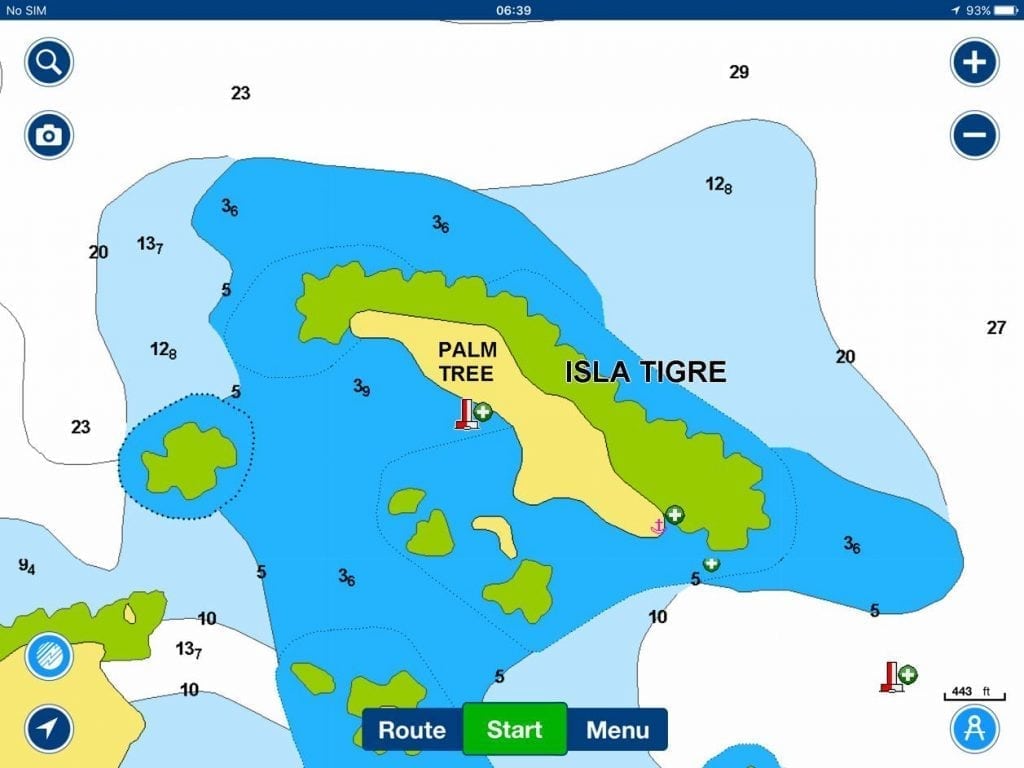 – «Stop !! Attention! There’s a reef in front of you !» he yells. The Italian skipper runs to the cockpit, cuts the throttle, turns the helm and the boat turns 180 °. -“Thank you so much! This reef does not show on the map!”, he says. Yet the reef is there…
– «Stop !! Attention! There’s a reef in front of you !» he yells. The Italian skipper runs to the cockpit, cuts the throttle, turns the helm and the boat turns 180 °. -“Thank you so much! This reef does not show on the map!”, he says. Yet the reef is there…
Soon we are all in the dinghy, approaching 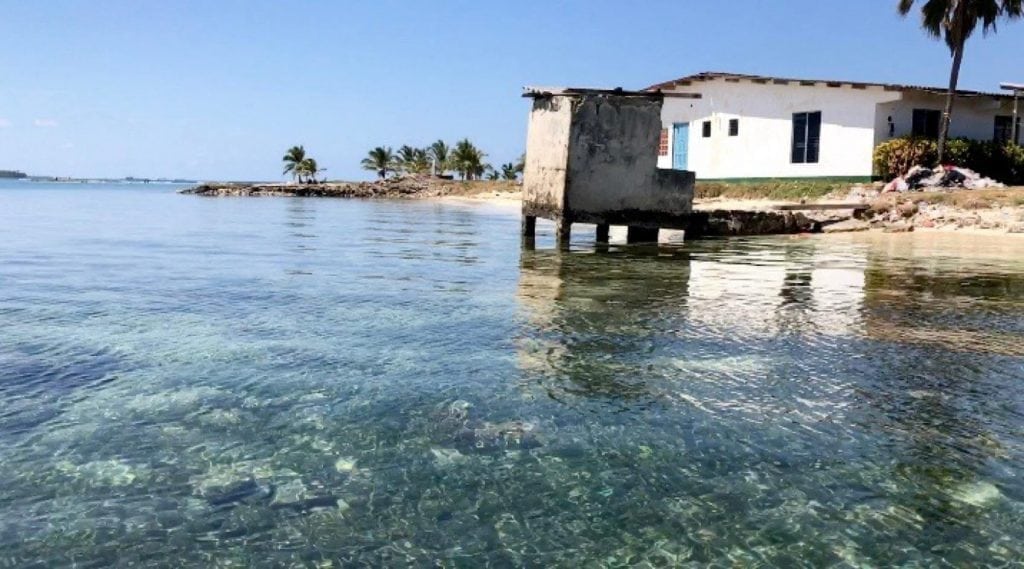 the coast. On the waterfront, a series of tiny piers are built leading to small cabins of bamboo or brick.
the coast. On the waterfront, a series of tiny piers are built leading to small cabins of bamboo or brick.
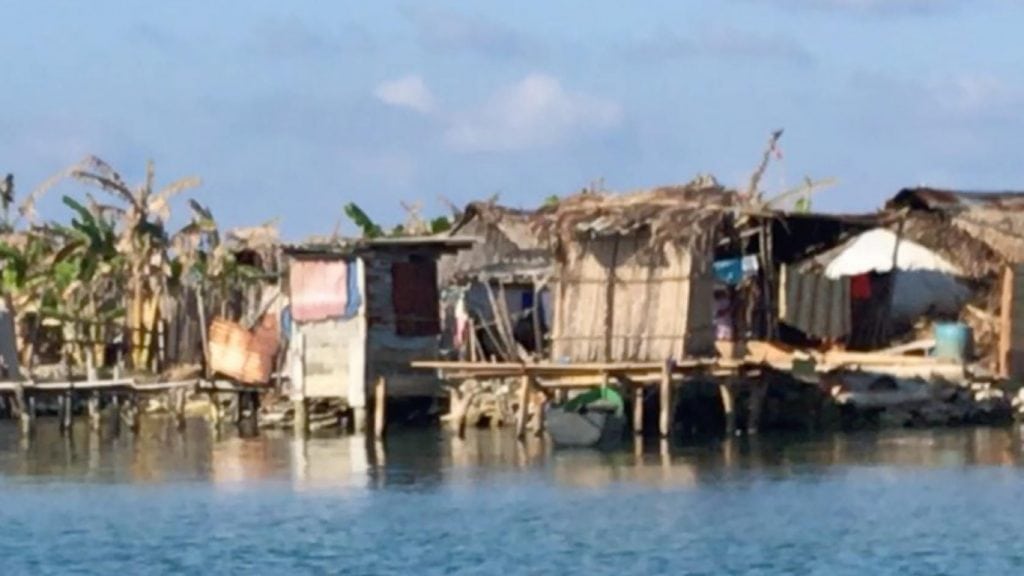
– “Their toilets?” we wonder. Nice view!
14.00 We tie the tender on an ancient pier. The sun is hot and Vasso’s white hands are already getting pink. The sun is different here in Panama at 9 ° North, 9 × 60NM = 540 nautical miles from the equator. Only! The sun burns much, much more than it does in the Caribbean islands of 12 °N or 18N °.
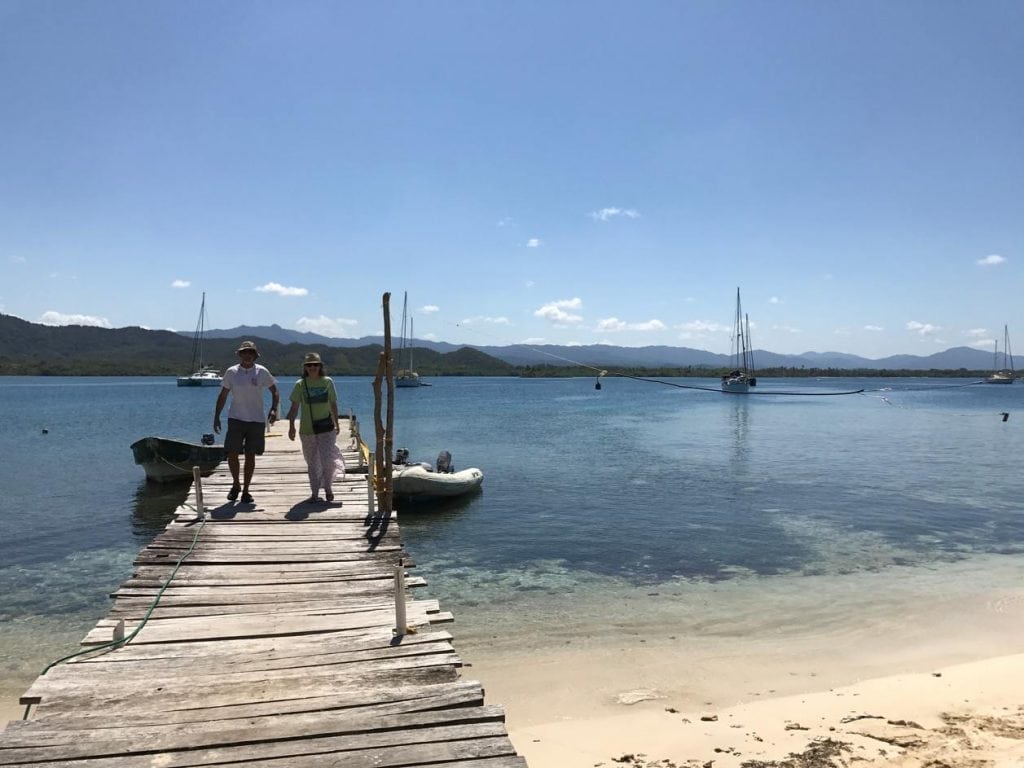 We walk on the island. To the left, there’s a restaurant, with it’s tables all set and some people having lunch. On the opposite shore, over an open area covered with thick grass, are three bungalows, like a small hotel.
We walk on the island. To the left, there’s a restaurant, with it’s tables all set and some people having lunch. On the opposite shore, over an open area covered with thick grass, are three bungalows, like a small hotel.
We pass under a wooden gate and enter the village.
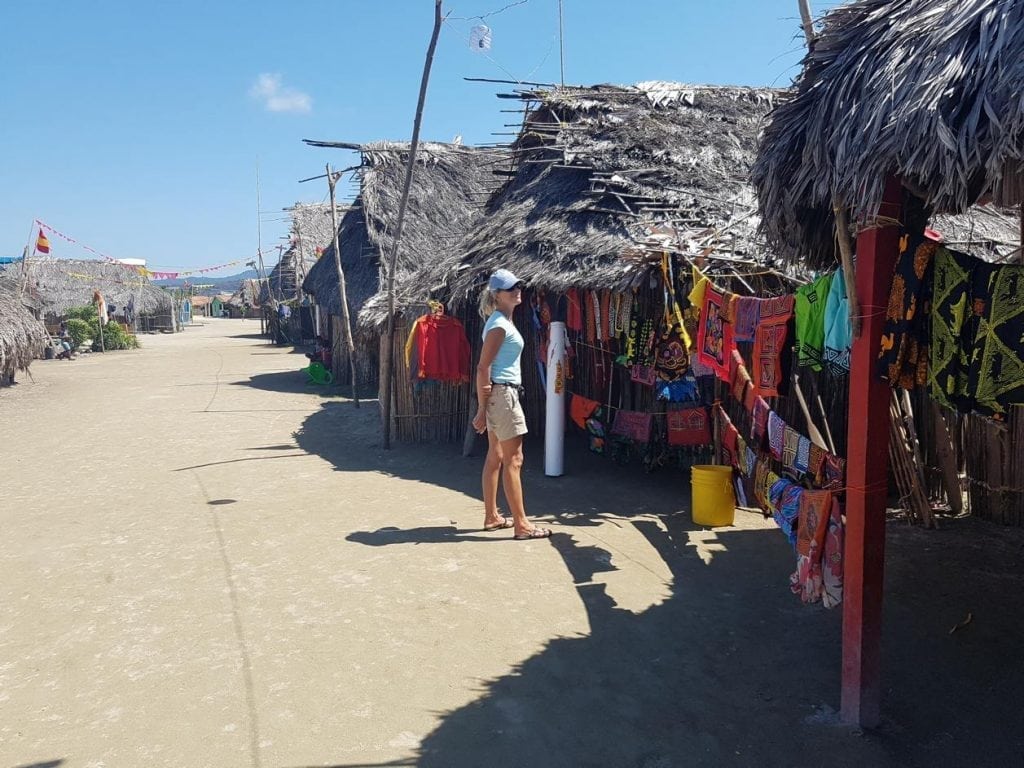 There are two parallel roads and on each side there are huts made of thin cane with thatched roofs. The road , made of from pressed sand is perfectly clean . From the open door of a hut comes a woman dressed in traditional clothes of Guna Yala and a small child, that’s holding tight to her skirt. As she see us she goes back in, and reappears holding some Molas, the handicrafts of the guna women.
There are two parallel roads and on each side there are huts made of thin cane with thatched roofs. The road , made of from pressed sand is perfectly clean . From the open door of a hut comes a woman dressed in traditional clothes of Guna Yala and a small child, that’s holding tight to her skirt. As she see us she goes back in, and reappears holding some Molas, the handicrafts of the guna women.
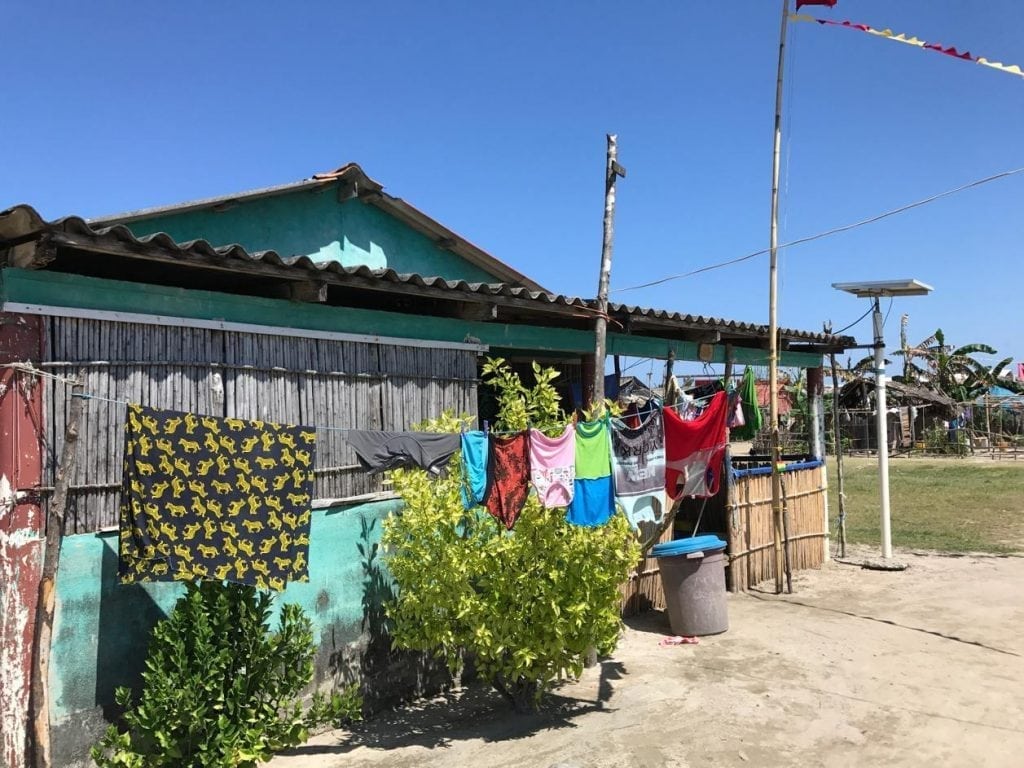 She looks shy, lowering her eyes and whispers something in a language with sharp, short phrases. Her “Molas” are pretty but look simpler than the molas of the “master molas” Venancio , that visit us with his boat one day.
She looks shy, lowering her eyes and whispers something in a language with sharp, short phrases. Her “Molas” are pretty but look simpler than the molas of the “master molas” Venancio , that visit us with his boat one day.
We thank her and we go on to see the village. Passing by I throw a peek into the hut from the open door. 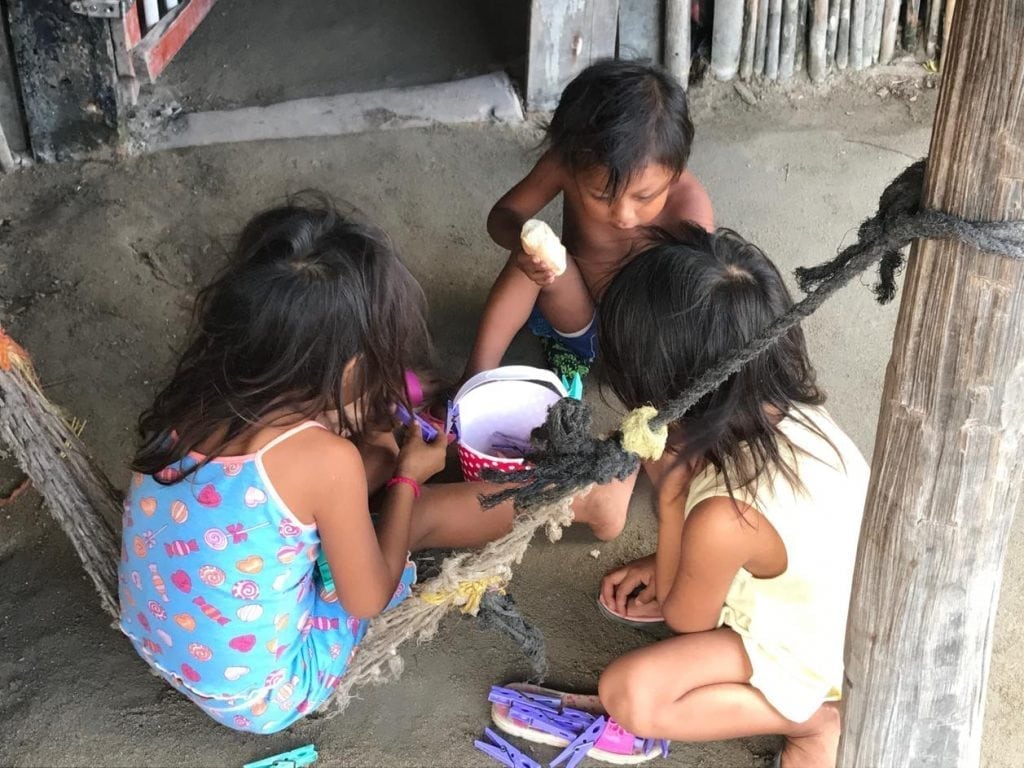 Lit by the sun light passing through the canes, the hut looks empty except for a table and some hammocks. Two kids are playing on the floor.
Lit by the sun light passing through the canes, the hut looks empty except for a table and some hammocks. Two kids are playing on the floor.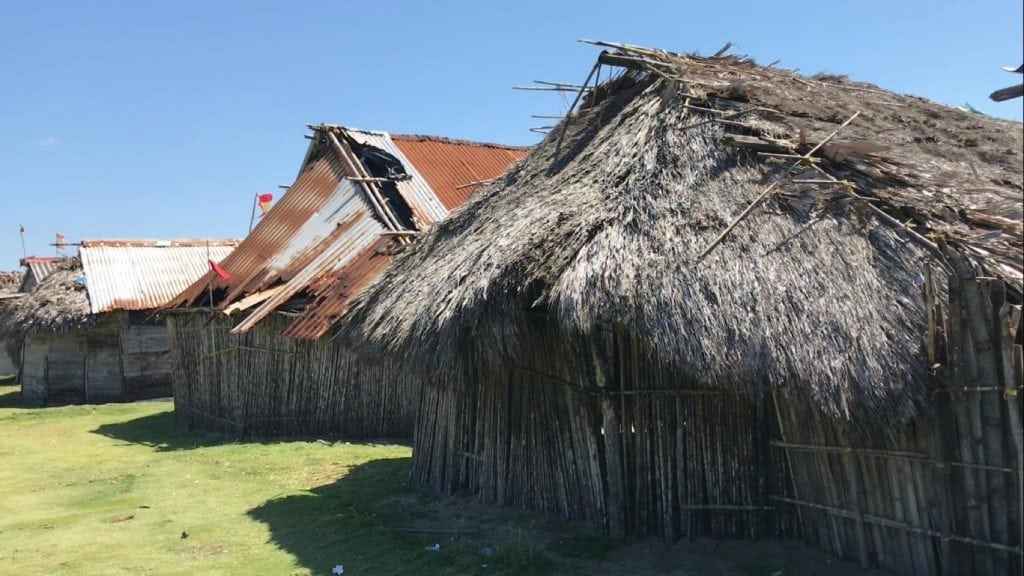
The sun is hot and we are all alone on the road . The village is decorated with colorful flags and flags of Guna Yala , a yellow flag with a blag swastika in the middle..
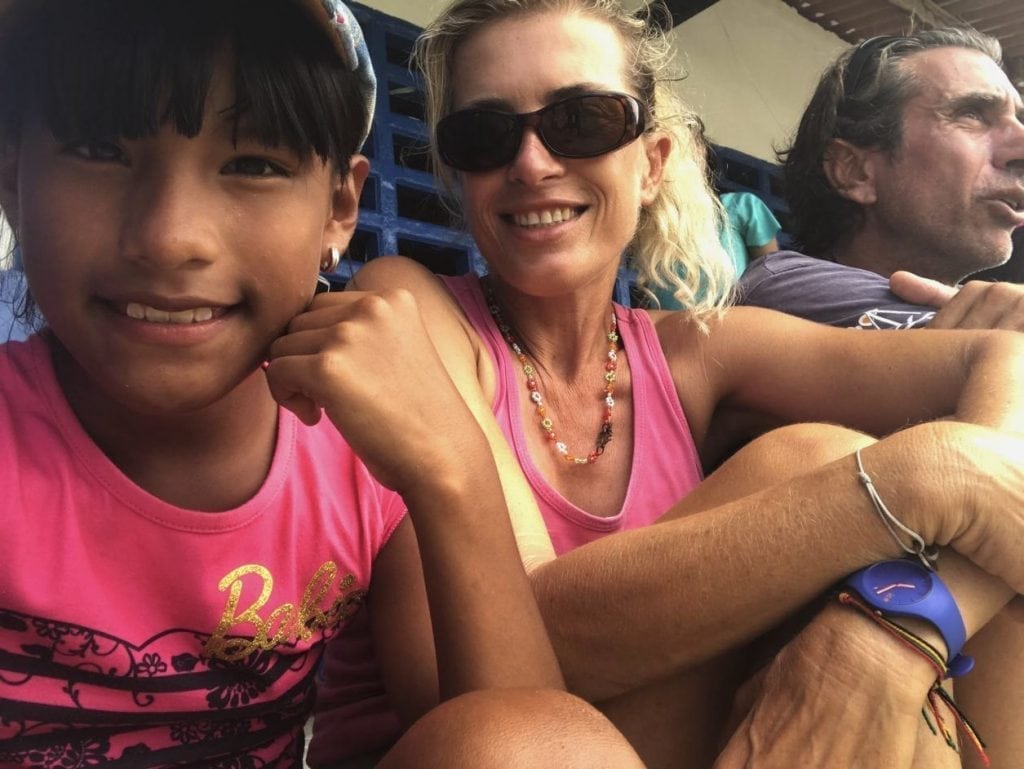 As we walk, more women appear from the huts, molas in their hands. They are all petite and dressed with the traditional way of their tribe . All same but all different. Their hair is cut short, they wear a red headscarf, gold ring on the nose and their cheeks are painted red. In the neck they wear necklaces made of colored beads. Their hands are covered from the wrist to the elbow with ornate bracelets from beads called chaquiras.
As we walk, more women appear from the huts, molas in their hands. They are all petite and dressed with the traditional way of their tribe . All same but all different. Their hair is cut short, they wear a red headscarf, gold ring on the nose and their cheeks are painted red. In the neck they wear necklaces made of colored beads. Their hands are covered from the wrist to the elbow with ornate bracelets from beads called chaquiras.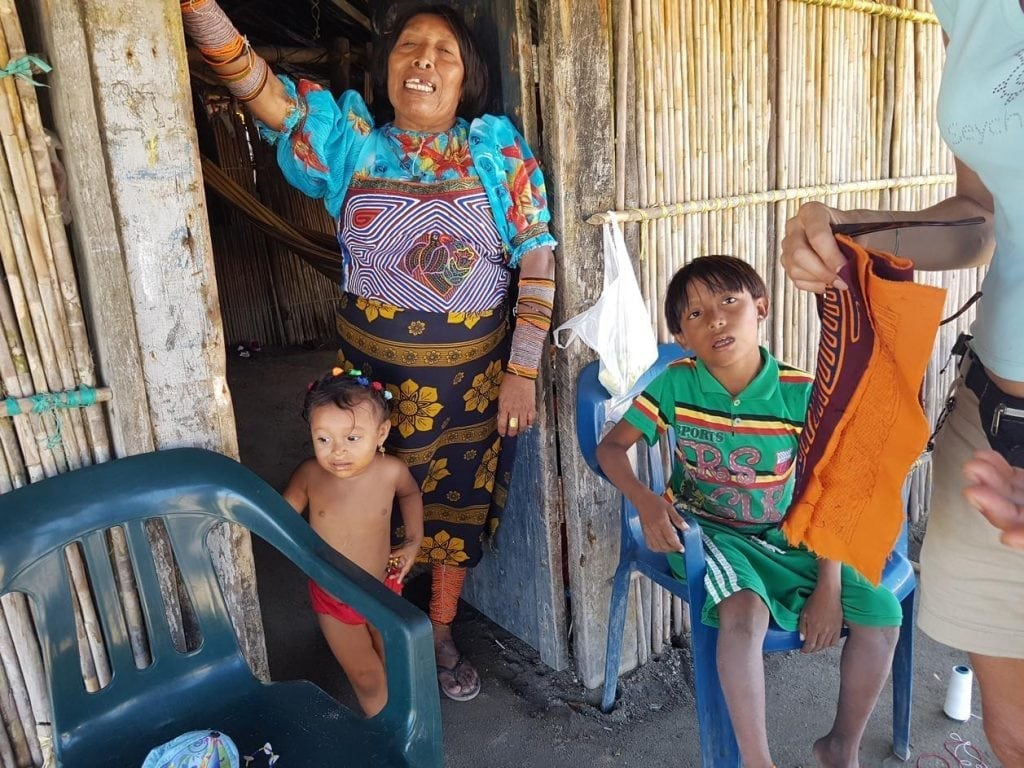
And their legs too, from the ankle to the knee with beads that are called WINI. Their shirts are made of fine fabric and are adorned front and back with embroidered Molas. The skirts are a simple piece of cloth, wrapped around the waist, usually black with bright yellow or green projects. As soon as we raise our mobile phones to take a picture, they all hide their homes.
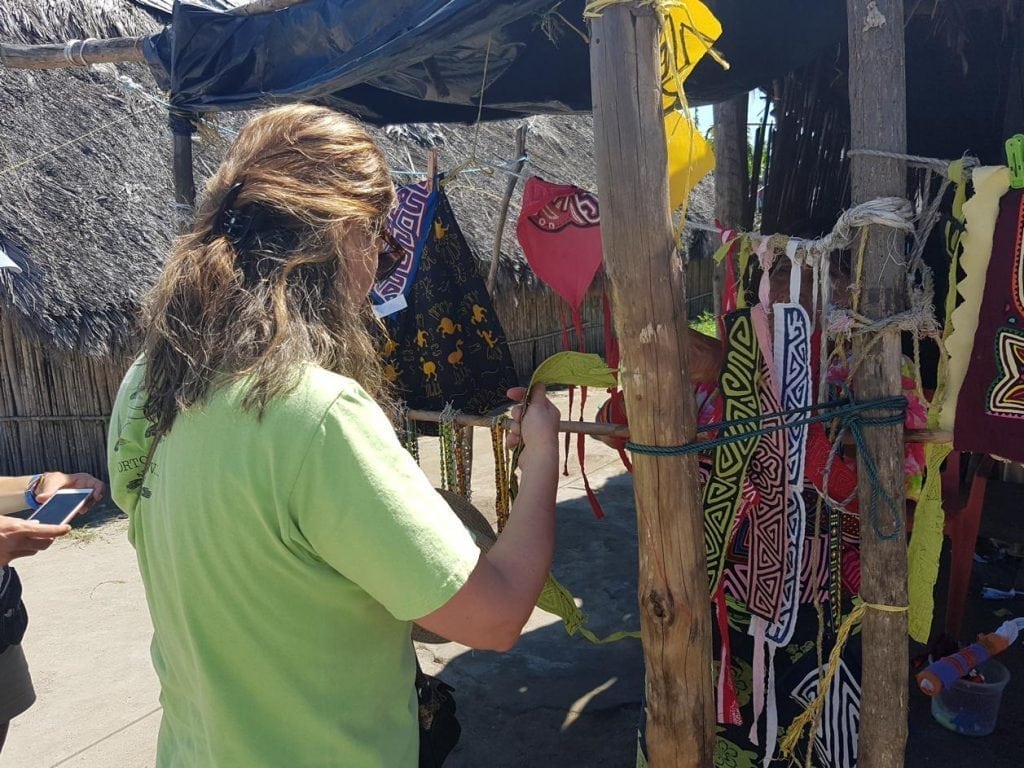 A sweet old lady shows us her beautiful hair bands made with the molas technique. Vasso and I we look at the head bands – «Quando costa?” I ask the price – “Three dollars” the old lady answers, takes Vasso by the hand and takes into the hut. Yorgos and I follow the lady with the incredible voice and enter in a big hut.
A sweet old lady shows us her beautiful hair bands made with the molas technique. Vasso and I we look at the head bands – «Quando costa?” I ask the price – “Three dollars” the old lady answers, takes Vasso by the hand and takes into the hut. Yorgos and I follow the lady with the incredible voice and enter in a big hut.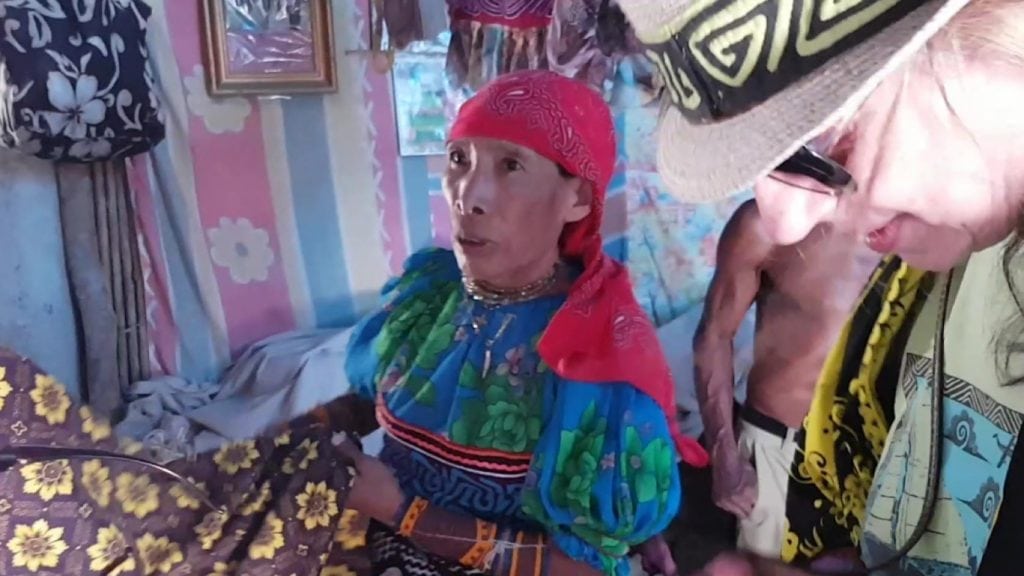
Seniora Angelina takes down some of the fabrics that hung from ropes, and she shows us one by one with pride – “Estrellas del mar!” Starfish she says pointing a black cloth with yellow shapes, “Tortuga” Turtle she says , pointing another fabric.
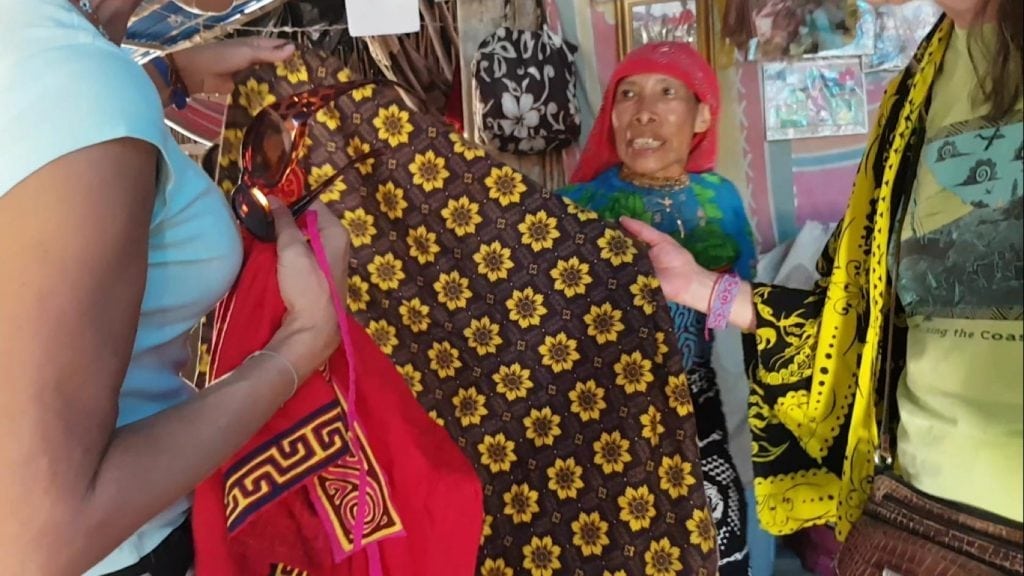 After a while, we leave the hut with 2 sarongs, headbands and necklaces of beads. A few meters further we come to an opening that must be the central square. On the left a platform is set up and three men are working . I approach to ask them.
After a while, we leave the hut with 2 sarongs, headbands and necklaces of beads. A few meters further we come to an opening that must be the central square. On the left a platform is set up and three men are working . I approach to ask them.
– «Hola seniores. Tiene celebracion hoy? “Do you have a celebration today, I ask with a trace of hope.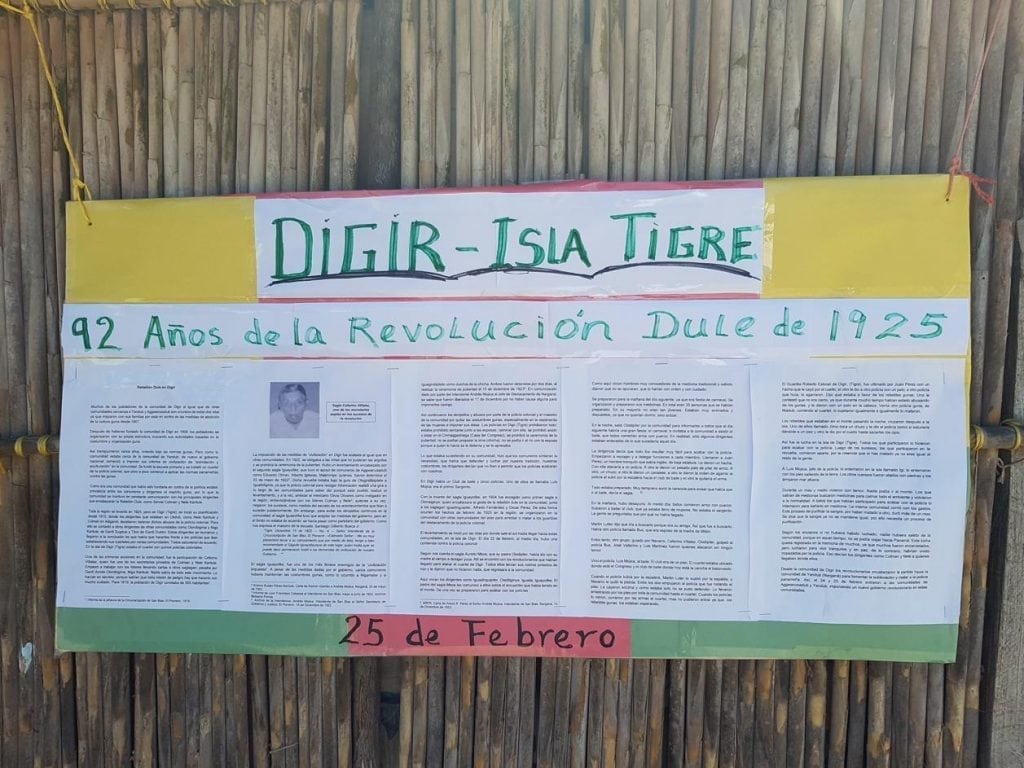
-« Esta terminada “finished, they answer . It’s a pity we missed this celebration. Today the village celebrated the rebellion against Panama launched on 21 February 1925. This revolution developed and brought partial autonomy in 1930 and full administrative and judicial independence in 1953. Since 1925 the Gunas are forbidden to marry non Guna people. Anyone who breaks this law is banished from Guna Yala.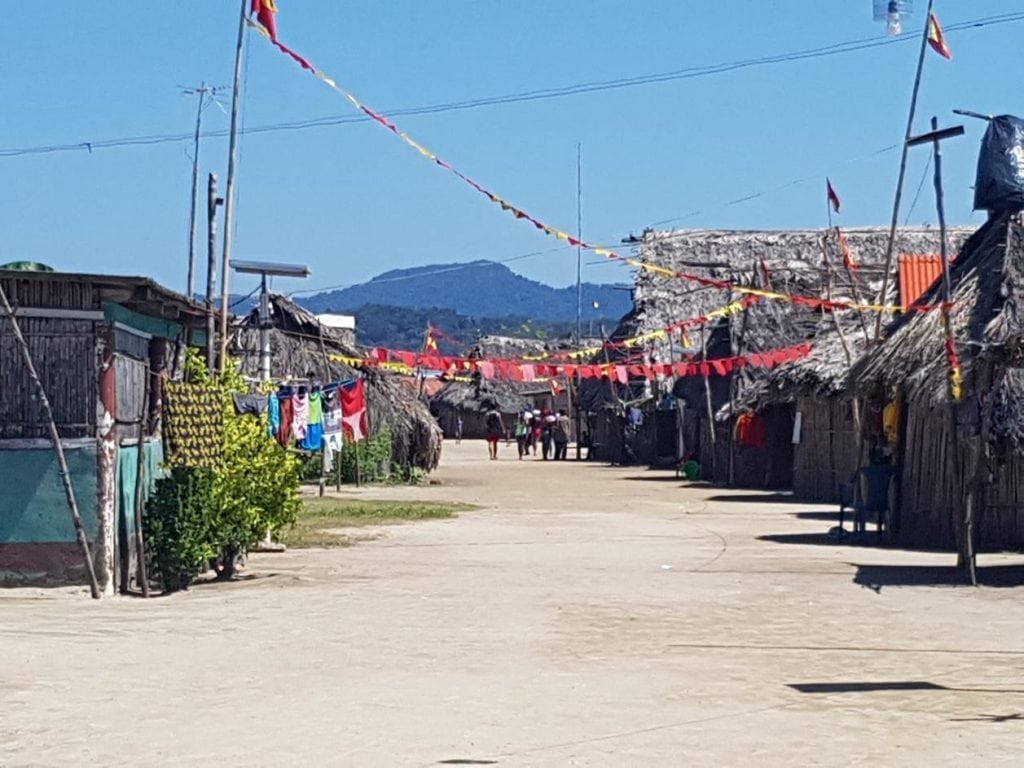
On the opposite side of the square is a very large hut, with wooden benches inside, and from what I have read I understand to be the “Congresso”, the village town hall.
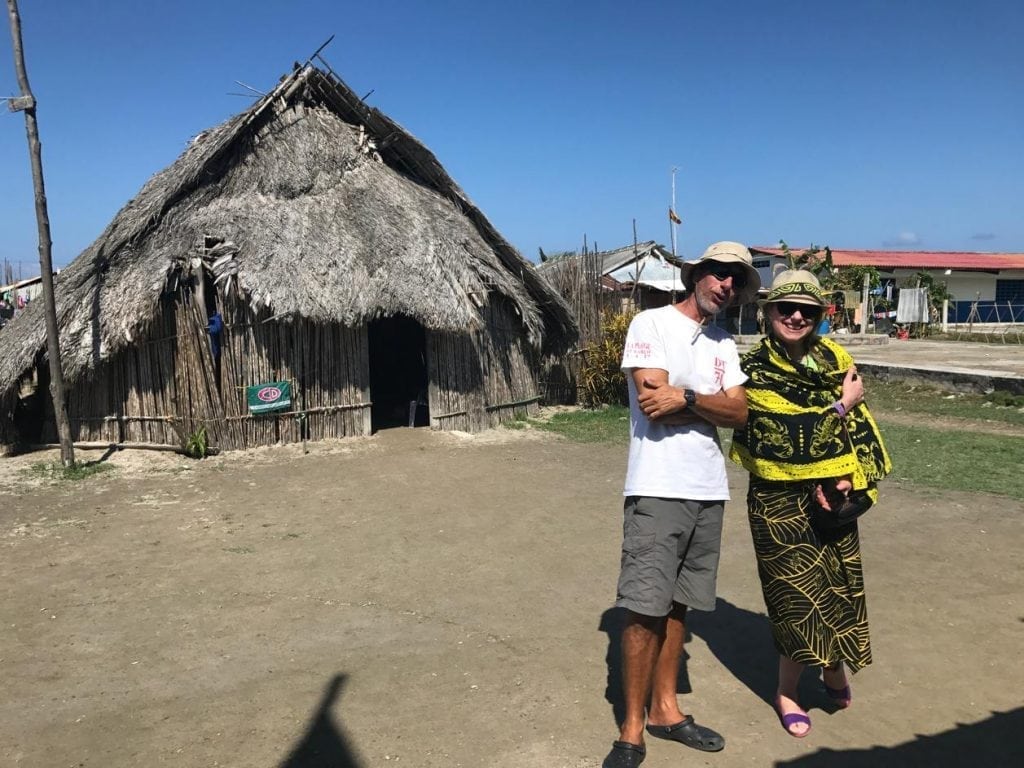 Each village in Guna Yala has three or four leaders called Sailas. The people gather in the Congresso to discuss village issues with their leaders or to hear them singing the long songs that tell the story of their ancestors. We proceed admiring the beautiful village and stop in front of a hut.
Each village in Guna Yala has three or four leaders called Sailas. The people gather in the Congresso to discuss village issues with their leaders or to hear them singing the long songs that tell the story of their ancestors. We proceed admiring the beautiful village and stop in front of a hut. 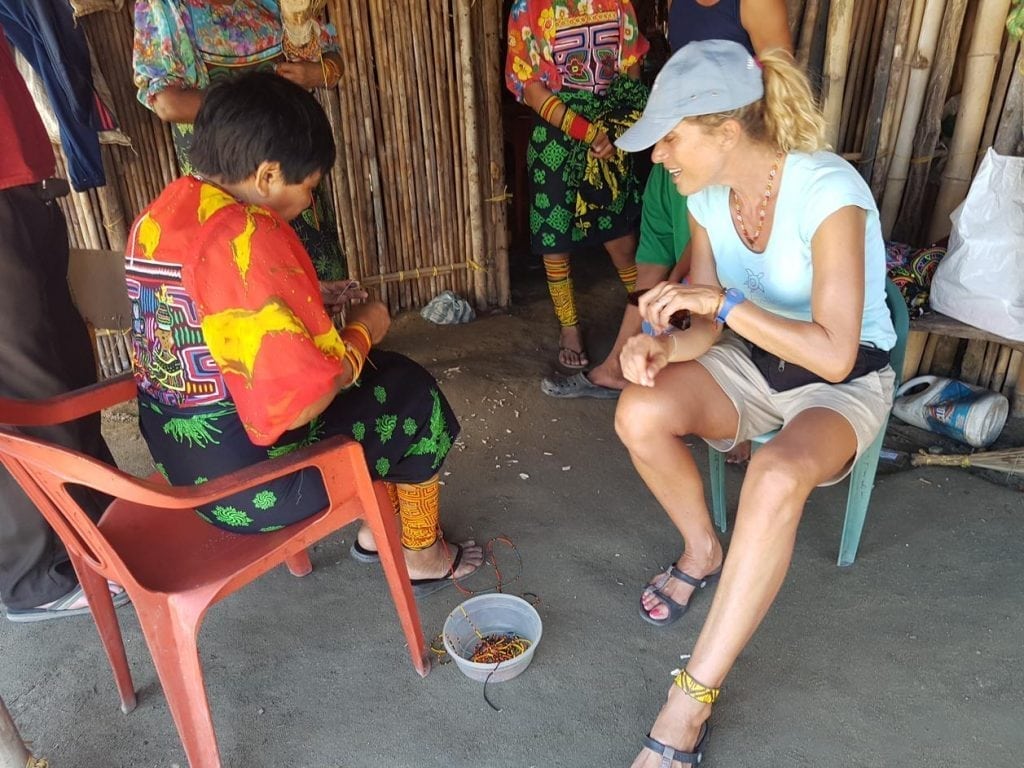 Under the covered front porch are three women with of clay dishes filled with colorful beads by their feet. We ask one of the women if I can have a wini and she shows me a chair to sit . A tall albino man appears at the door and greets us in English. I ask the woman how much the wini costs in Spanish and the Albino man answers. Strange, because the society in Guna Yala is matriarchal and usually the money is managed by women. But this is not an ordinary man, he is an albino and as such, he has an important place in this society. It is impressive. So far in my life I had heard only about prejudices against the albino, especially in Africa. There are many albino in Guna Yala, a characteristic and important figures in all villages.
Under the covered front porch are three women with of clay dishes filled with colorful beads by their feet. We ask one of the women if I can have a wini and she shows me a chair to sit . A tall albino man appears at the door and greets us in English. I ask the woman how much the wini costs in Spanish and the Albino man answers. Strange, because the society in Guna Yala is matriarchal and usually the money is managed by women. But this is not an ordinary man, he is an albino and as such, he has an important place in this society. It is impressive. So far in my life I had heard only about prejudices against the albino, especially in Africa. There are many albino in Guna Yala, a characteristic and important figures in all villages.
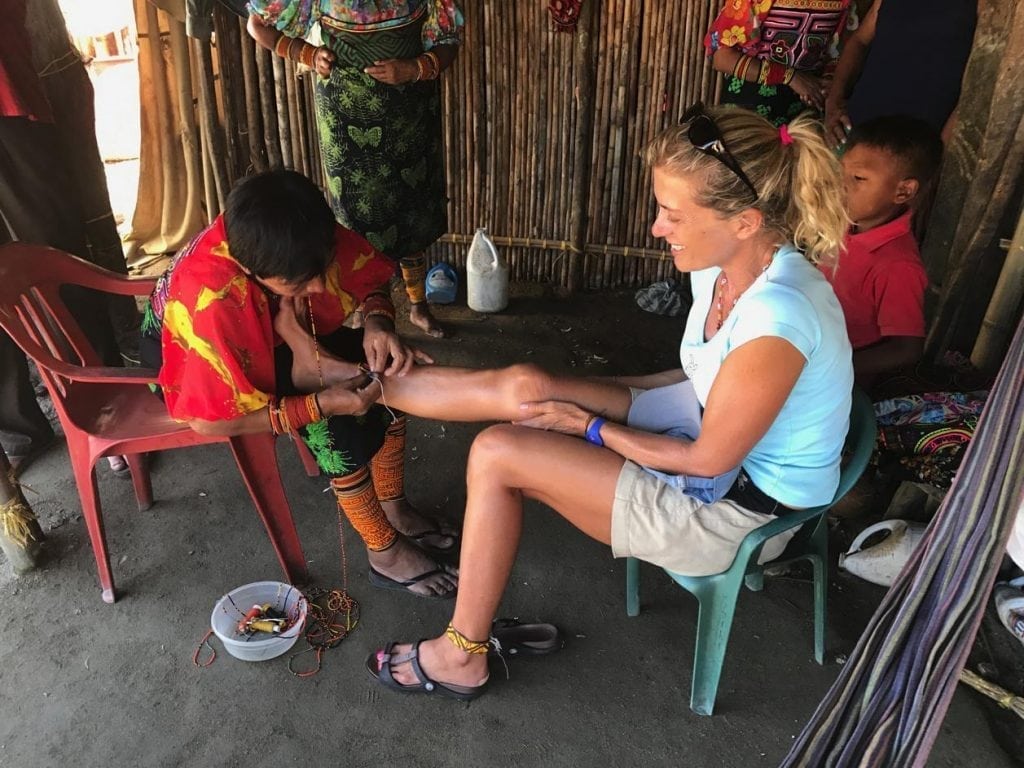 I sit in the chair and watch the woman wrap the endless thread of beads, just above my ankle. Magically, with each new set of beads a pretty design formed. My wini looks wonderful and it must end after 13th rounds of beads.
I sit in the chair and watch the woman wrap the endless thread of beads, just above my ankle. Magically, with each new set of beads a pretty design formed. My wini looks wonderful and it must end after 13th rounds of beads. 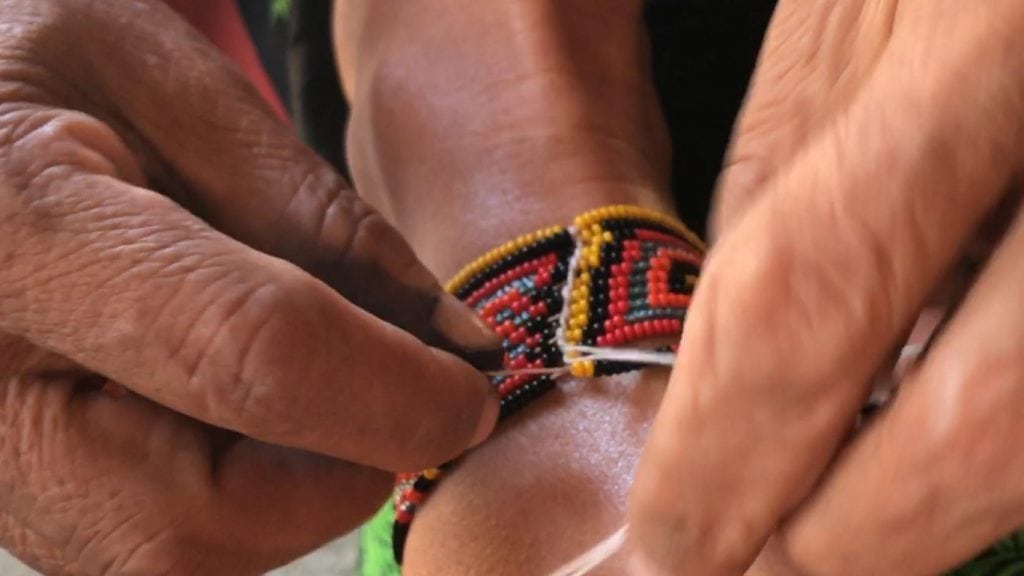 “Basta” I say. Vasso says she wants a wini too. The woman stars working on her, with new beads and different colors. When the job is done, the man gives us a 50% discount. Our wini were small.
“Basta” I say. Vasso says she wants a wini too. The woman stars working on her, with new beads and different colors. When the job is done, the man gives us a 50% discount. Our wini were small.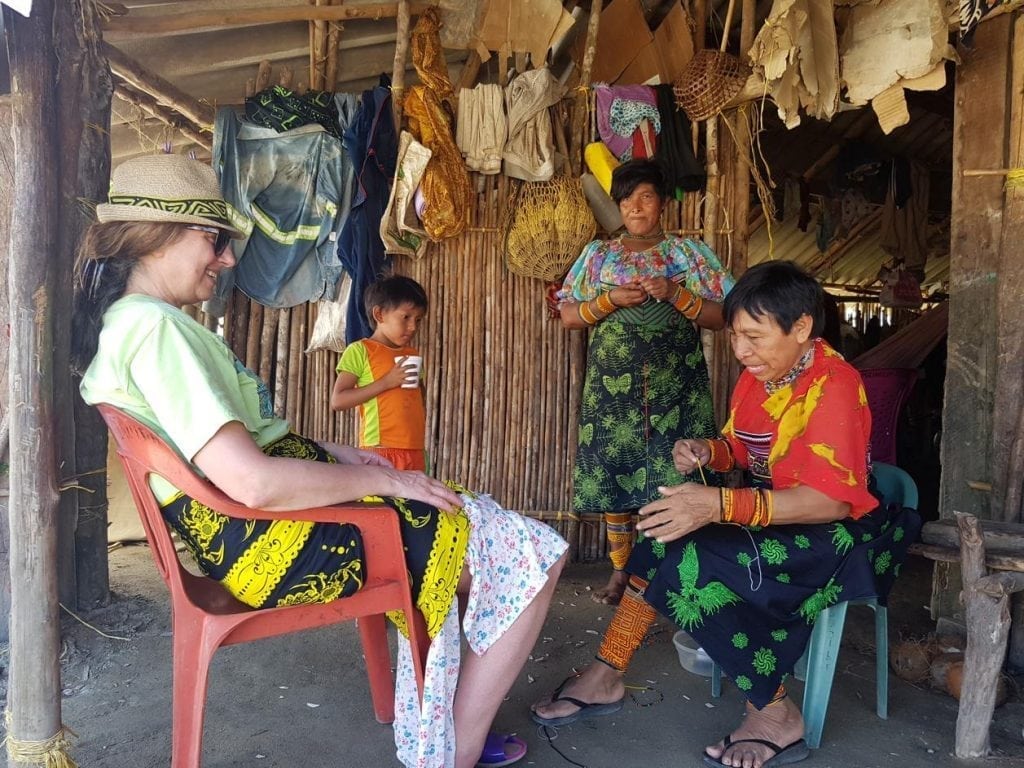
We walk again, Vasso is covered with new guna sarongs and I with her long skirt ad the sun burns my skin, too. With brisk step we leave the village and go to the restaurant close to our dinghy. I’m craving for fresh coconut milk. We sit at the table and a man asks what we’ll have. Hearing us discussing in Greek, the man asks where we come from. De Grecia we say. The man then says: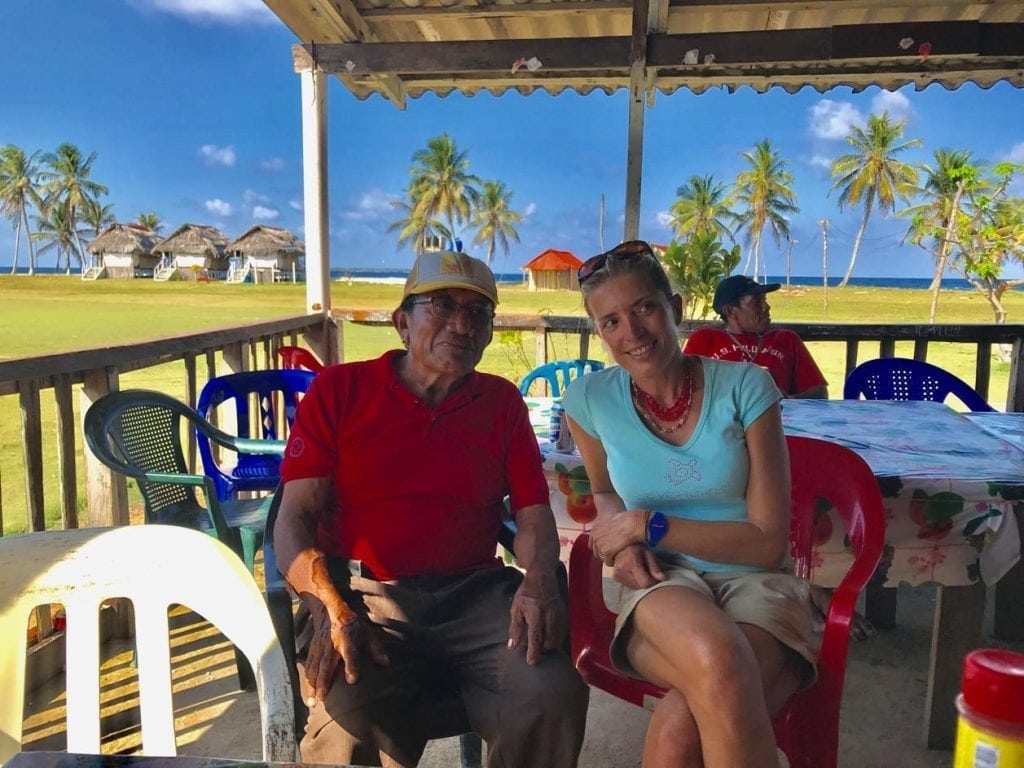
– «Dadme un punto de apo to y movere ‘en mundo” the man says. My Spanish is not great but I understand immediately what the man said
– “Give me a lever and I will move the Earth! Archimedes. Unbelievable … ” The philhellene guna sends us someone to fetch fresh coconuts from a tree. Chatting with him, we tell him how sorry we are for missing the celebration today. – “Then, you must come back,” he says. “In three days start the sports games, “Juegos Ancestrales de Digir”, the Games of Our Ancestors.”
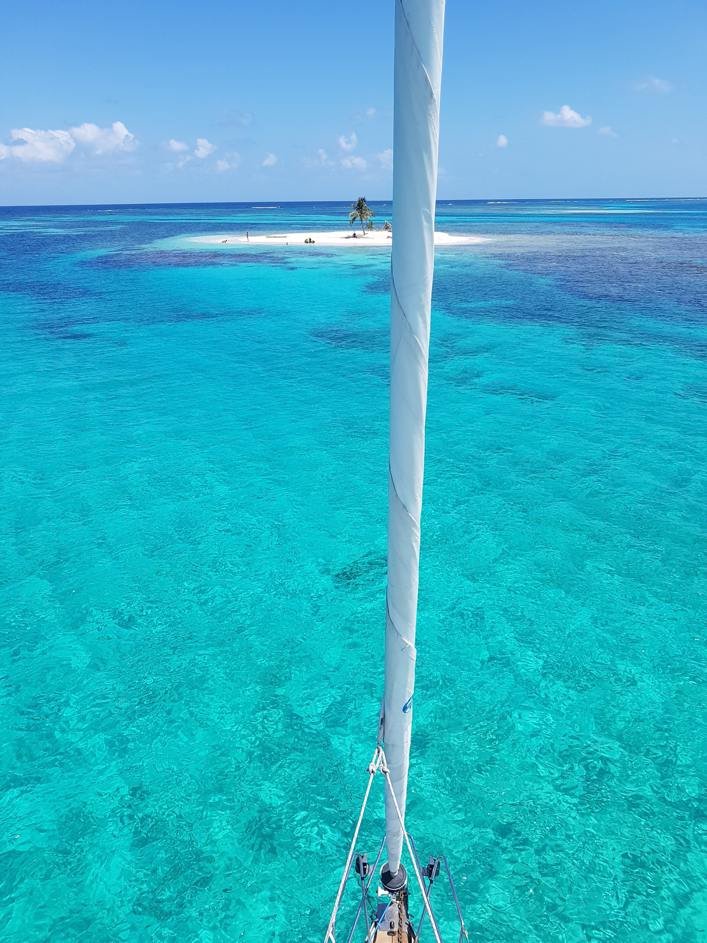 31.115 N ° 9 78 ° 38.845W
31.115 N ° 9 78 ° 38.845W
Coco Bandero West, Orduptarboat island
Wednesday March 1st
14.00 For three days we have been anchored in the heavenly Orduptarboat island of Coco Bandero west, next to the tiny island with just one palm that I call One-Palm-Island.
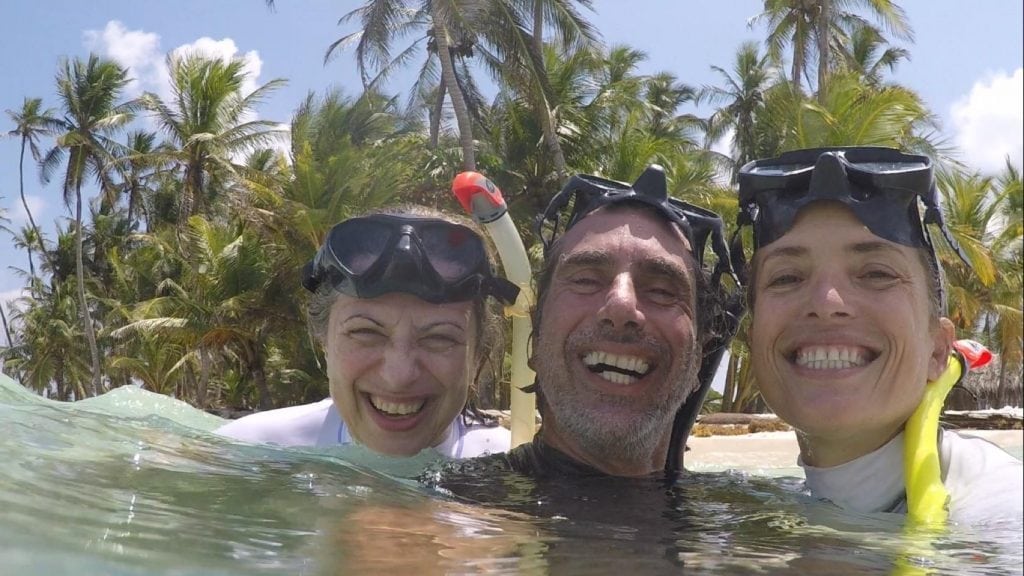 We enjoy the beauty and serenity all alone. Although no other boat is here, we feel completely safe, something that we never experienced elsewhere in the Caribbean.
We enjoy the beauty and serenity all alone. Although no other boat is here, we feel completely safe, something that we never experienced elsewhere in the Caribbean. 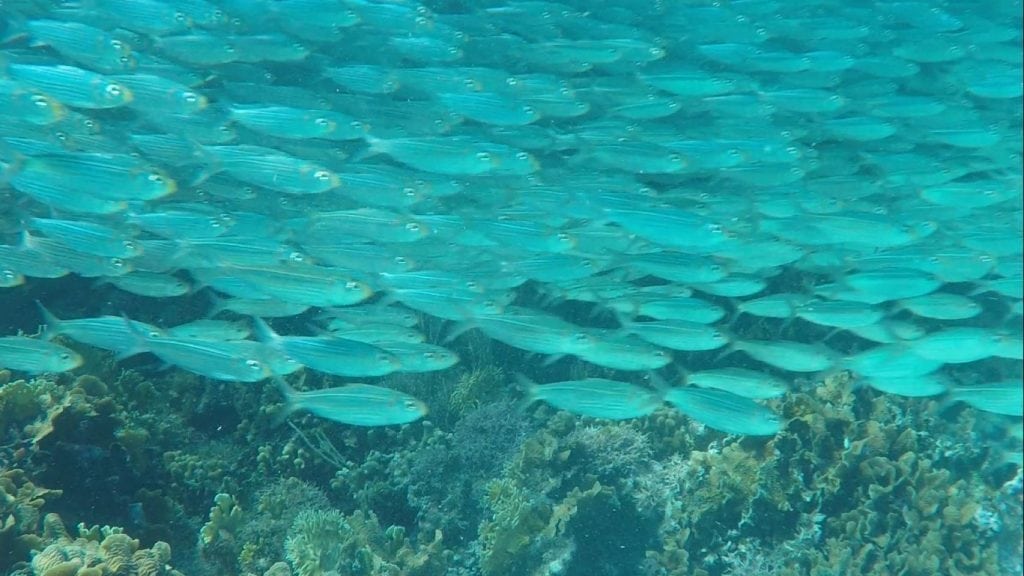 After a splendid snorkeling around the reef of One-Palm-Island, we swim towards Orduptarboat and I go ashore to find our friend Gianluca.
After a splendid snorkeling around the reef of One-Palm-Island, we swim towards Orduptarboat and I go ashore to find our friend Gianluca.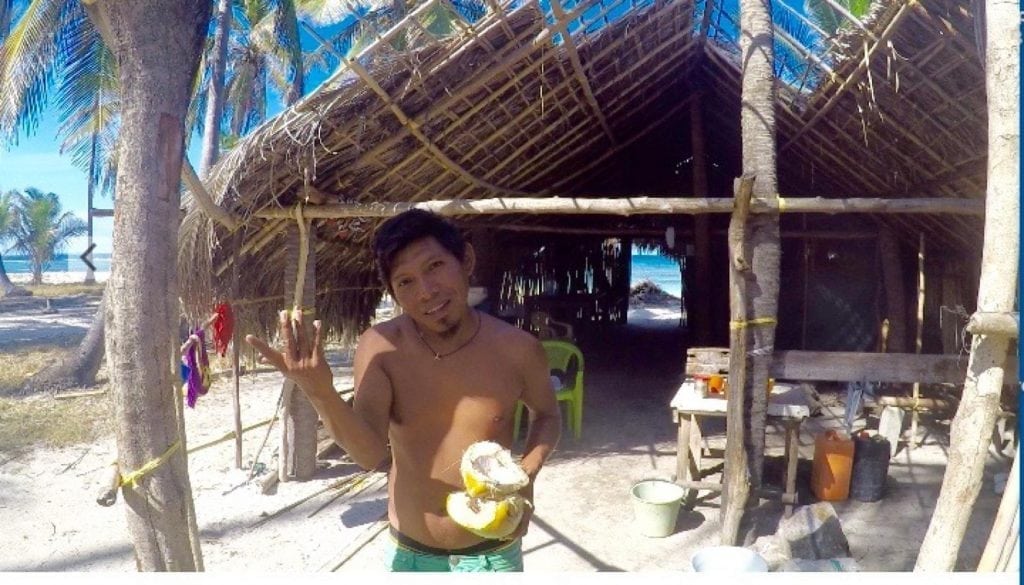 I find him carrying jerry cans of water from a boat to their hut. I ask him – on captain’s request- if speargun fishing is legal and he says yes. Then I ask If they could bring us fish and coconuts. He’s surprised. No, the fish is not for me, he knows I am a vegetarian. Giancarlo says they will bring coconuts and fish to Filizi in an hour. We must not be late, we are going to Tigre today, his mother’s island for the Juegos Ancestrales.
I find him carrying jerry cans of water from a boat to their hut. I ask him – on captain’s request- if speargun fishing is legal and he says yes. Then I ask If they could bring us fish and coconuts. He’s surprised. No, the fish is not for me, he knows I am a vegetarian. Giancarlo says they will bring coconuts and fish to Filizi in an hour. We must not be late, we are going to Tigre today, his mother’s island for the Juegos Ancestrales.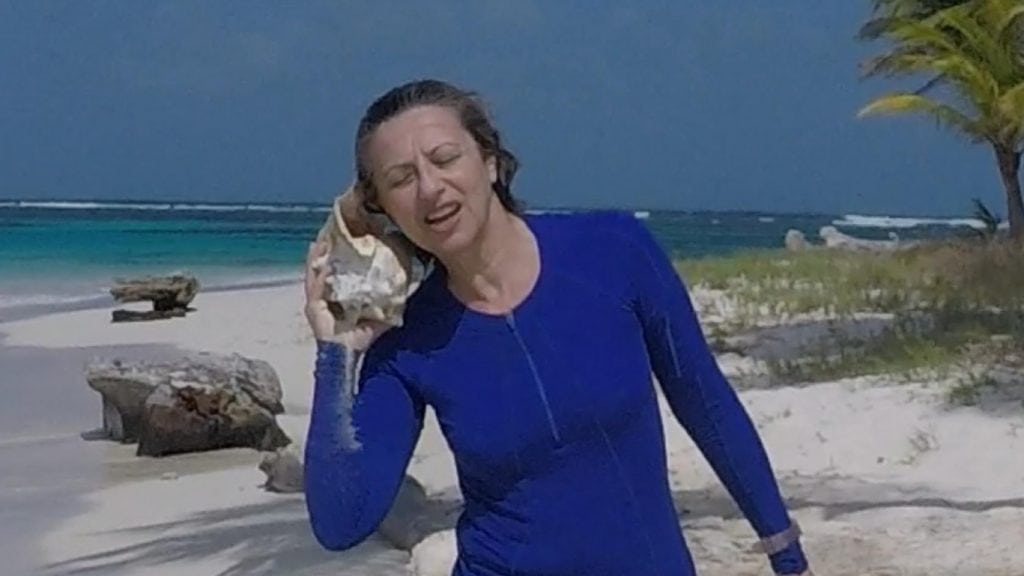
I give the news to Captain Yorgos and he doesn’t waist any time. He fetches his speargun, ready to go fishing, having Vasso companion for the fish. On the island coast, the 15 year old Seourelio, his father and Giancarlo, are pushing their ulu in the water.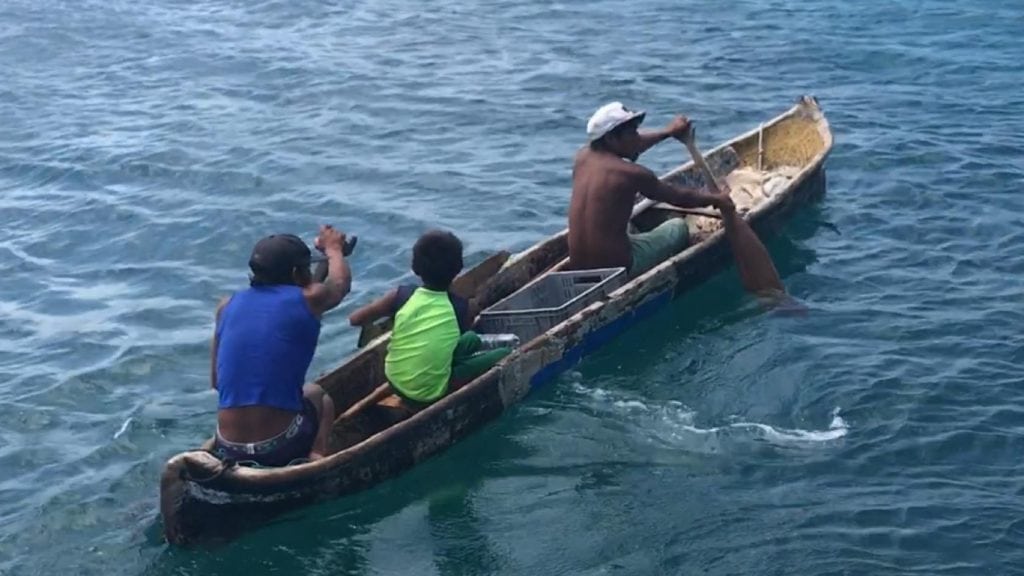
– “They go fishing” I say
– “They go fishing for us,” Vasso adds. -“Yes! And their only weapons are two harpoons! “Yorgos exclaims. He dives for snorkeling and I go with him. It scares me if he dives alone. We swim around for thirty minutes and we see no big fish, except two tuna- like fish. Yorgos caught one of them.
We return back to Filizi, finding Vasso working. Yorgos cleans the fish and I cook fried vegetarian meatballs and dooble-cooked potatoes with lemon and rosemary.
- “Hola Giancarlo!” I hear Yorgos say. I go out. The ulu is approaching from the stern.Giancarlo raises his hands and shows two fish, two yellow tail. Yorgos takes the fish and three coconuts ready to drink them.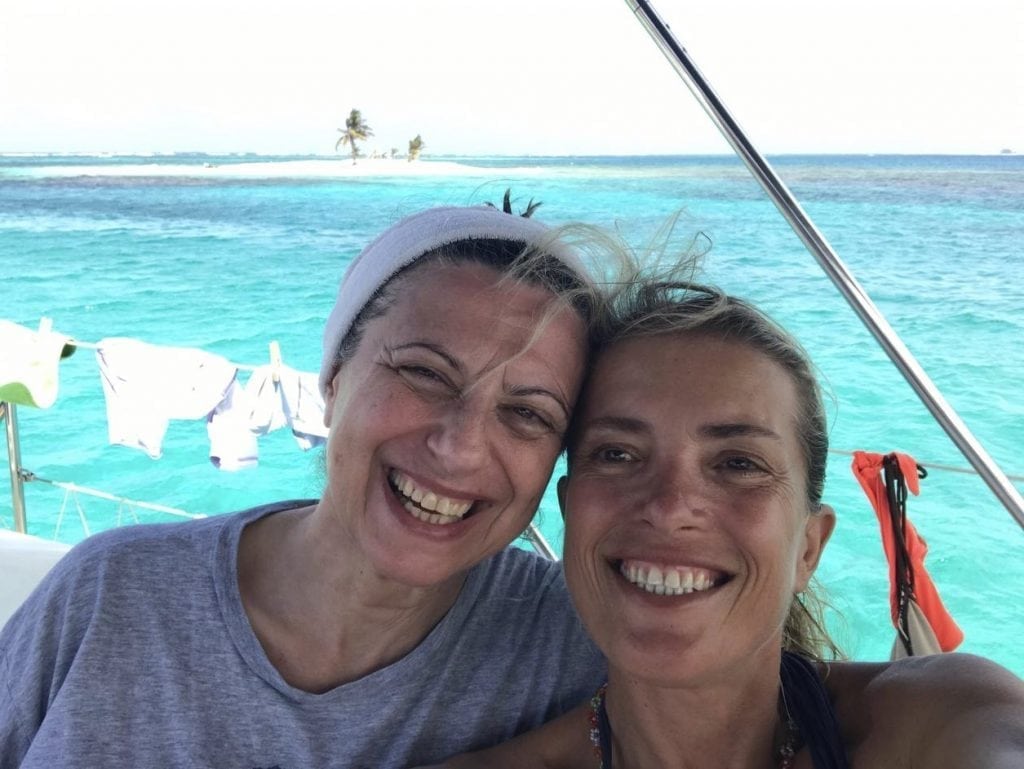
– “How much?” he asks
– “Eight dollars,” Giancarlo answers. The two fish cost five and one each coconut.
-“Will you go to my village today? ” our indian friend asks, refering to Isla Tigre. “Today and tomorrow are the last two days of Juegos Ancestrales sports games”.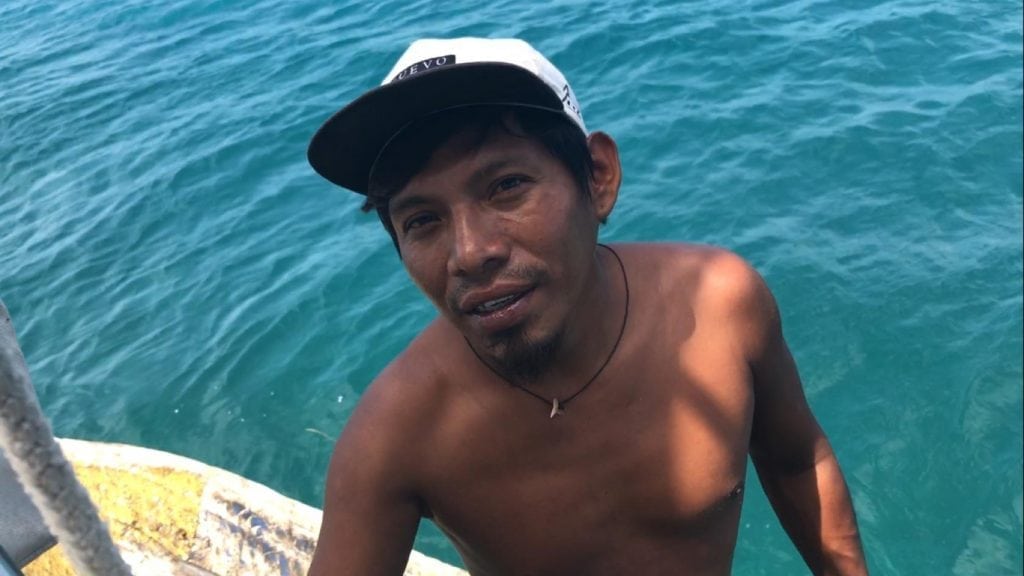
-“Of course we will. We’ll leave, after lunch” we answer. He looks happy. We say ” Hasta Luego” and they raw away.
This time we can not miss it, even though my heart is set here at our beloved Coco Bandero. The distance to Isla Tigre is ten miles and it will take us about two hours to get there, sailing broad reach with 20 kts if wind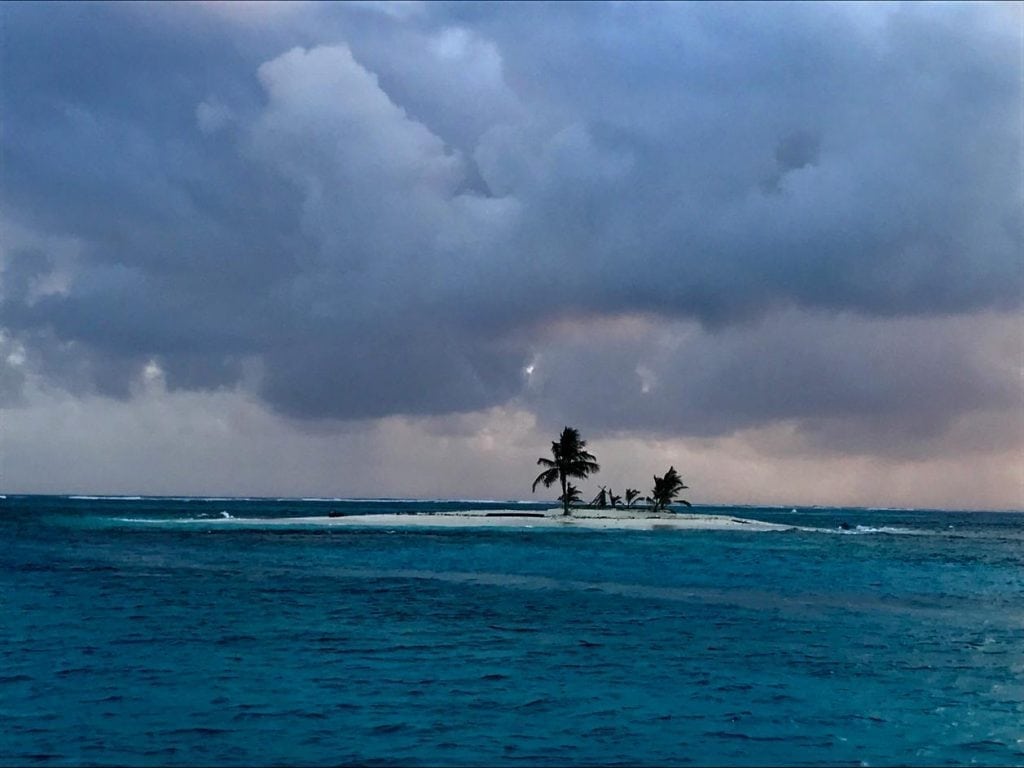
17.00 We arrive to Tigre and anchor at the same spot, but this time we are all alone in the anchorage. We put the dinghy on the water, take down the outboard and head ashore. Beyond the village gate, the eastern shore of the Tigre is covered by breaking waves. The wind is getting stronger. 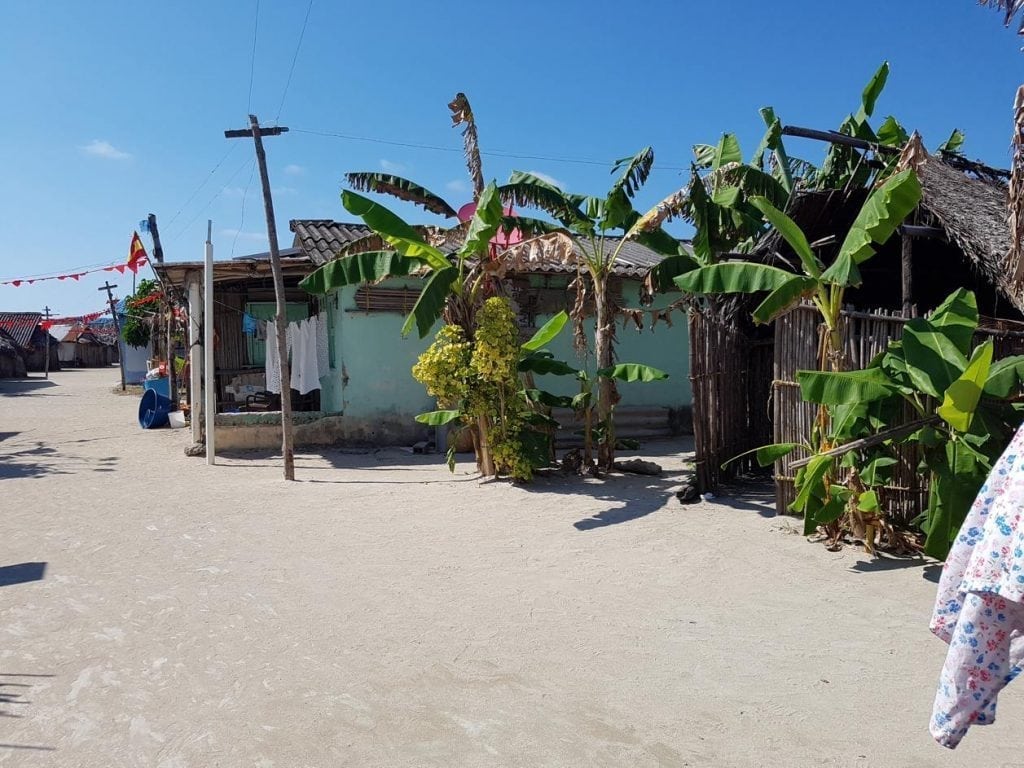 As we walk into the village we meet three children, a girl wearing a pink cap, matching shirt and shorts and two boys. The girl is pretty like a doll
As we walk into the village we meet three children, a girl wearing a pink cap, matching shirt and shorts and two boys. The girl is pretty like a doll
– «Hola! Que chica guapa! “I say smiling to her.
She giggles, putting her hand in front of her lips, and she shakes her long hair with complacency. She knows she’s beautiful. The road is decorated with flags and there are people everywhere. 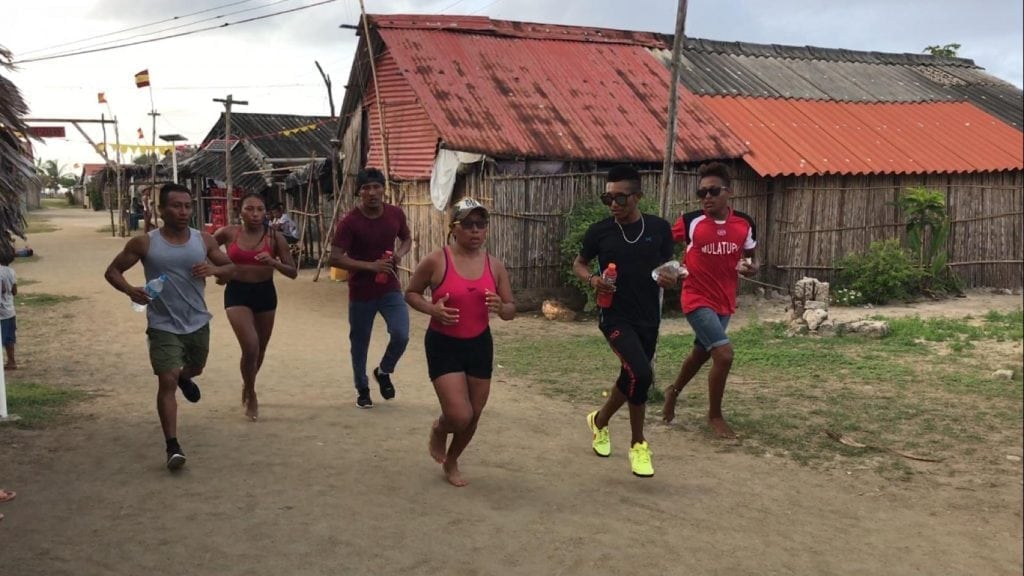 We reach the square. A group of running athletes passes. The female runners , dressed in shorts, have each two boys as assistants!! . One gives the athlete water to drink and the other cools her, sprinkling her with water. In the square outside the large hut of Congresso, several people are seated, among them three men wearing hats and eye glasses. They show very distinguished and reckon thay may be the chiefs of the village, called the “Sailas”. o
We reach the square. A group of running athletes passes. The female runners , dressed in shorts, have each two boys as assistants!! . One gives the athlete water to drink and the other cools her, sprinkling her with water. In the square outside the large hut of Congresso, several people are seated, among them three men wearing hats and eye glasses. They show very distinguished and reckon thay may be the chiefs of the village, called the “Sailas”. o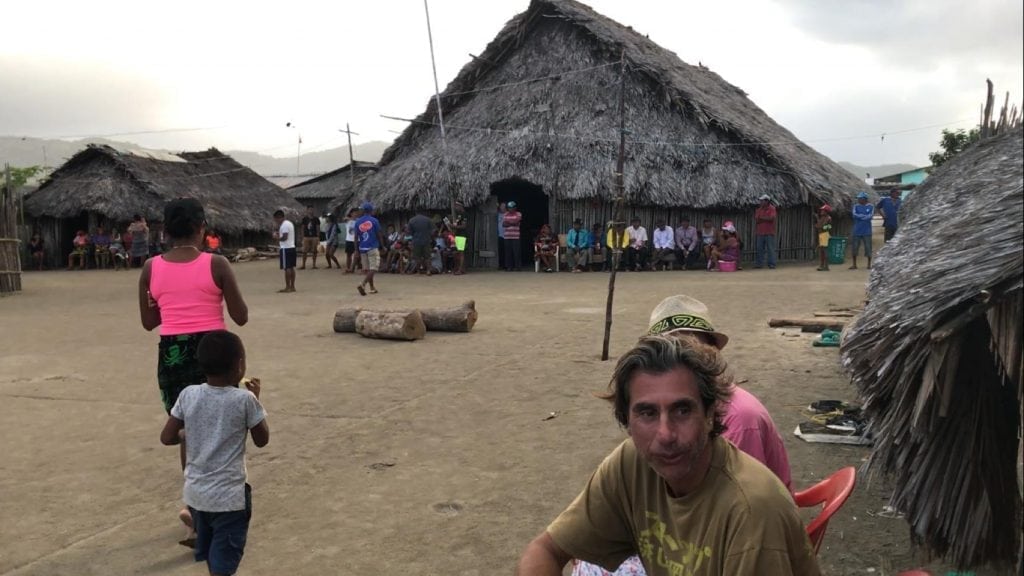 Outside of the neighboring huts, seated in plastic chairs are a dozen Guna women, all dressed with the traditional clothes. A group of kids are playing chase and two little girls play volleyball. The village is full of kids, playing merrily.
Outside of the neighboring huts, seated in plastic chairs are a dozen Guna women, all dressed with the traditional clothes. A group of kids are playing chase and two little girls play volleyball. The village is full of kids, playing merrily. 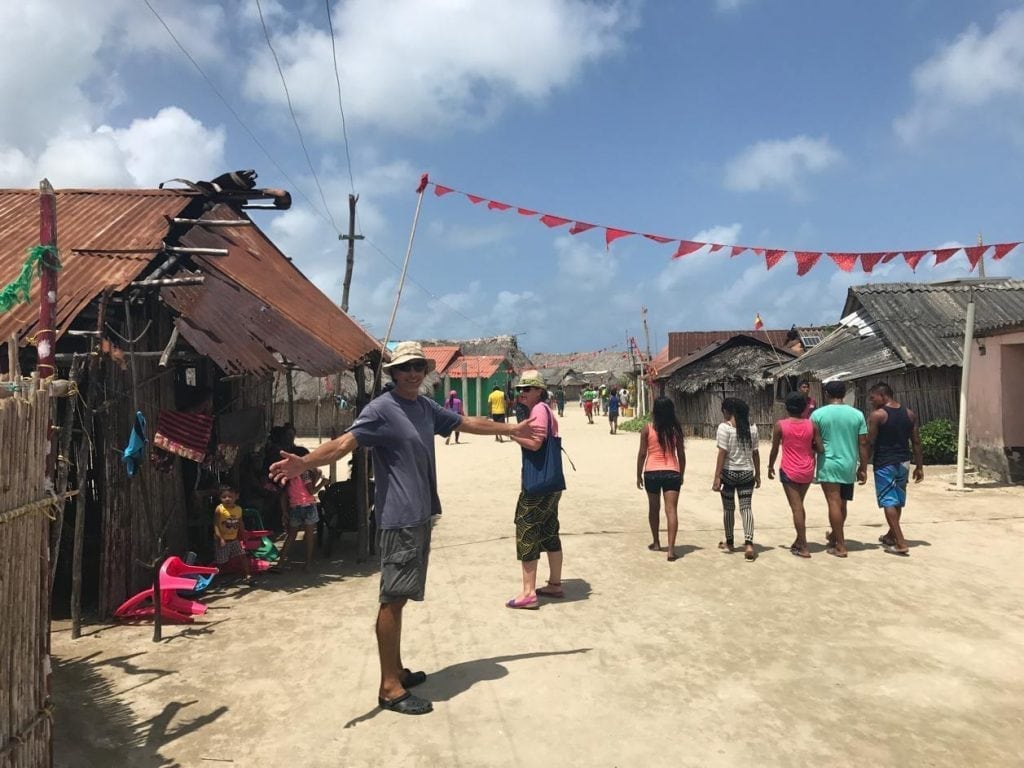 The runners make one more lap, the athletes are running barefoot but their companions are wearing sports.
The runners make one more lap, the athletes are running barefoot but their companions are wearing sports.
A young woman is standing next to and I ask her about the race. She explains they run 10km. The 10km race for men was earlier today. She tells me that the athletes are all Guna from Tigre and from Panama Guna. She says with pride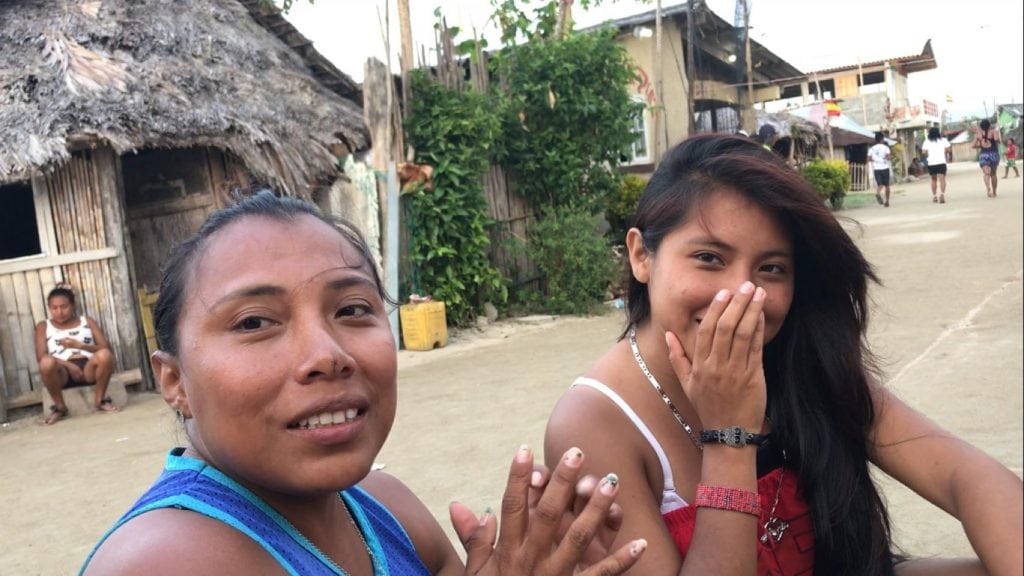
– “In April here in Digir (as Tigre is called in their language) we have Olympic Games! Indians will come from Canada, and throughout South America.”
Next to her, come her three daughters, and one of them is the pretty teenager with the pink cap. Mother and daughters are dressed in western clothes.
-” Come te llamas? what’s your name, they ask me. Karina I answer
– “My name is Yorgo, Jorge!” Yorgos says
– “And you” they ask our friend
– “Vasso” she answers. The children burst out laughing. Vasso (vaso) means glass, as glass of water in Spanish.
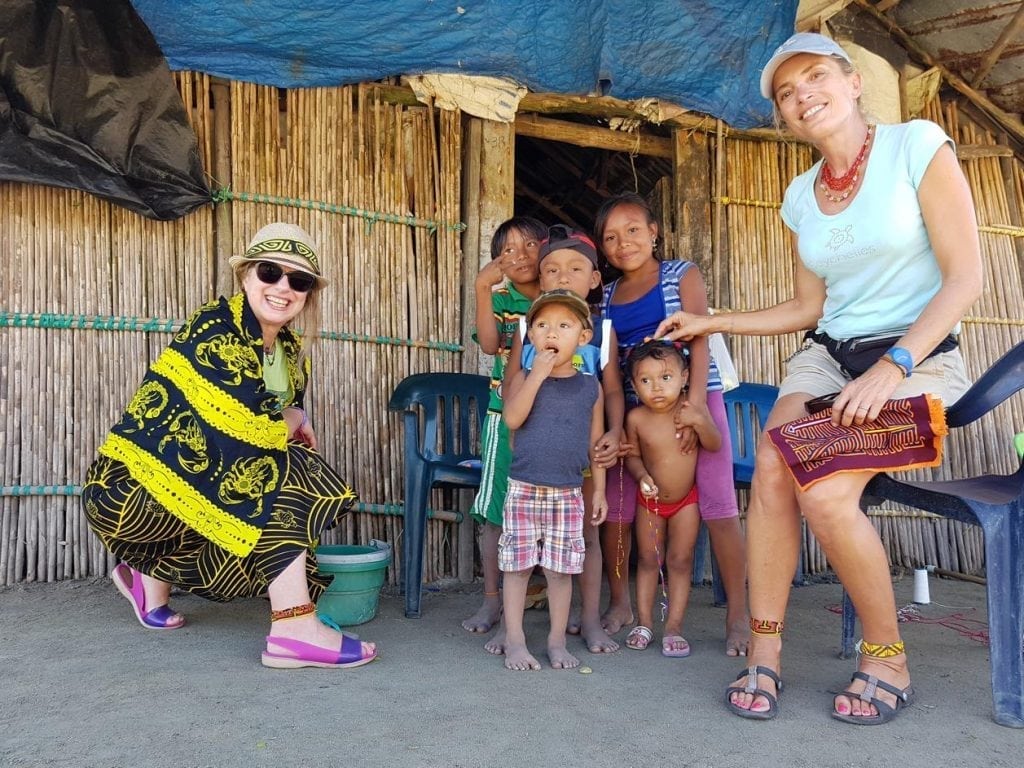 The girls are called Yoami , Nigili and Brizelia. They offer us plastic chairs to sit. Soon, the first runner crosses the finish line and the spectators applause. The girl falls down exhausted from the effort and her assistant lifts her gently up again .. A few minutes later comes the next runner and she collapses as well. Running ten kilometers in this heat is a feat.
The girls are called Yoami , Nigili and Brizelia. They offer us plastic chairs to sit. Soon, the first runner crosses the finish line and the spectators applause. The girl falls down exhausted from the effort and her assistant lifts her gently up again .. A few minutes later comes the next runner and she collapses as well. Running ten kilometers in this heat is a feat.
In the middle of the square lie three pieces of thick tree trunk and some young men are trying to push them aside.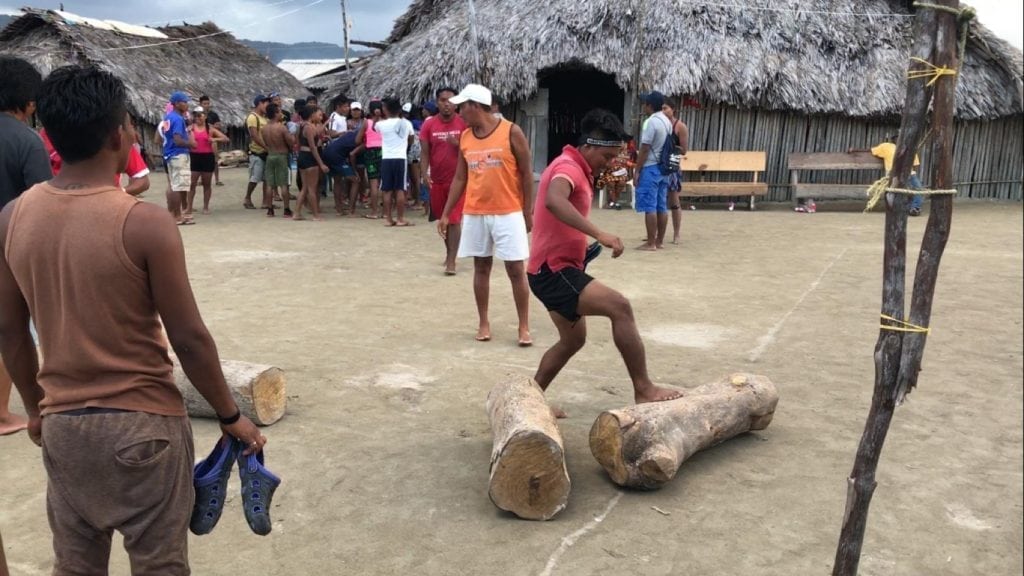
– “What are these;” I ask our friend
– “Those logs were lifted by the female athletes who did the triathlon” she answers.
-“Try for yourself if you dare” she says, smiling. I get up, approach the large woods and try to move one. Impossible.
-“But how ? ”
– “The girls lift the logs with the help of two men,” he explains laughing. Two girls approach Vasso – «Como te llamas?” what is your name? they ask her. Vasso answers her and the little ones giggle and run away. The race is over and a big group of children are gathered around us. They ask where we come from and we show them pictures of Greece on our mobile phones, beautiful pictures from Halki island, Aegina island and Milos.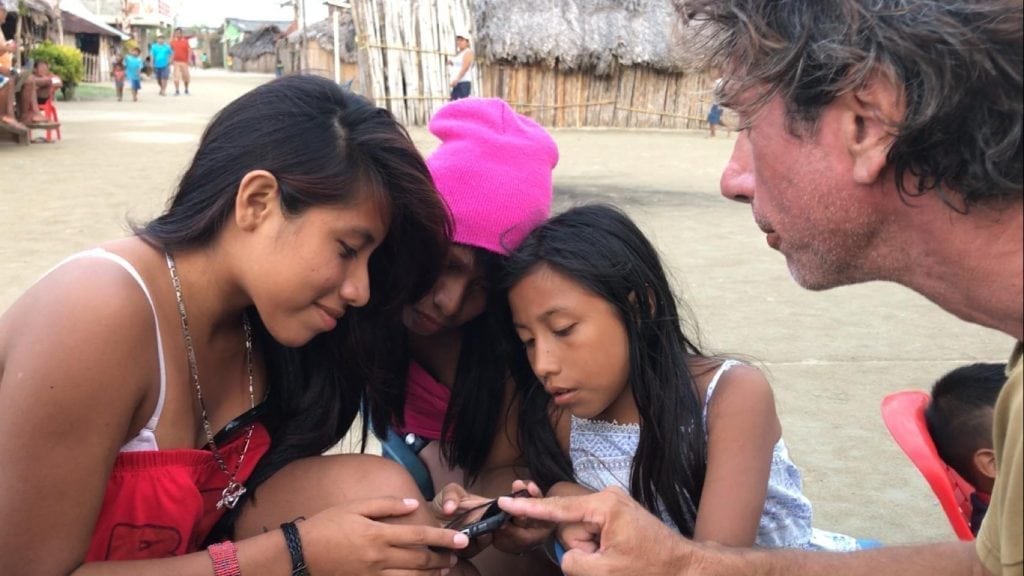
– «Que bonito !!” say the kids in admiration, seeing a photo of Halki with it’s colorful houses and emerald sea.
– «Si esta muy bonito. “Ne, te’lia” I say to myself in Greek!”, I say . More children gather around us, to see the photos. Yorgos looks at my mobile screen and he comments too
– “Telia”(perfect)!” The children ask what “Telia” means, perfect we answer.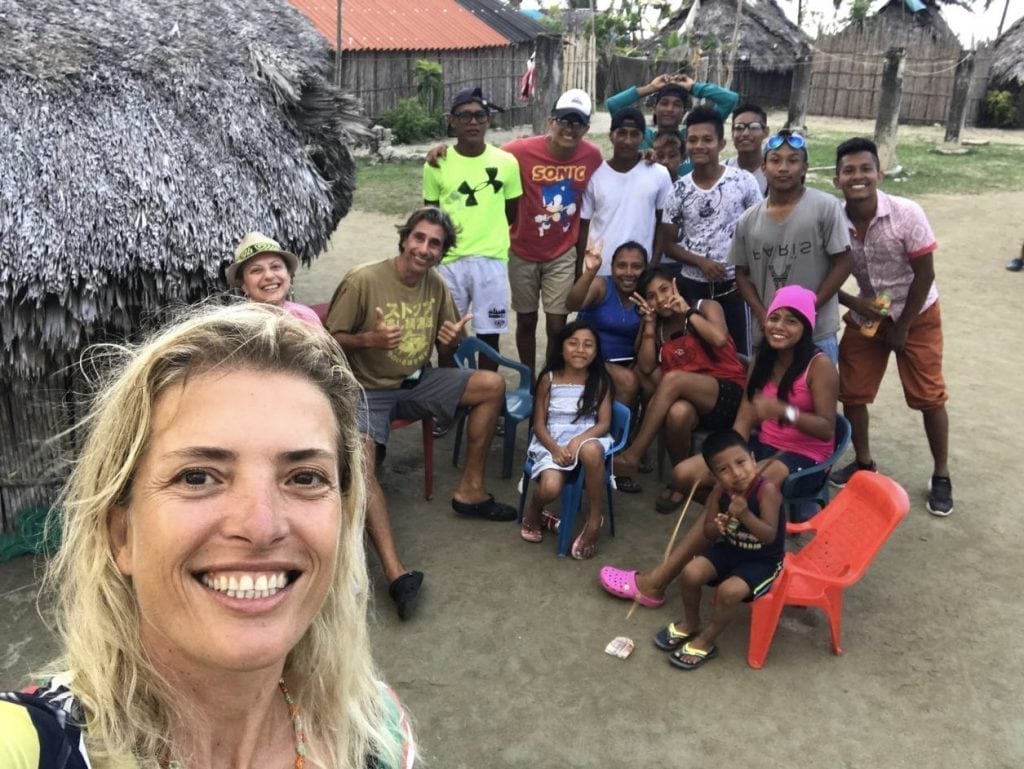
– «Telio” . – “Telioo, telio!” They repeat one after the other and it’s so nice and funny that I take video of us all. A man approaches and greets us in English.
– «Hello, Welcome to Tigre! ” He introduces himself, he’s called Ramiro Mores and comes from Costa Rica.
– “We invite you tonight at 8pm to attend the race of the rope, between the Guna of Tigre and Guna of Panama. After we’ll have local dances”, says Mr. Ramiro.
-“Thank you! We will come with great pleasure. Let me ask you sir, I would like a picture of a guna woman. Could you help? “I ask him
– “Certainly!” he answers. After five minutes a woman comes. Her face is very serious as she stands solemnly for a picture. She’s delicate and petite.
– “Muchas gracias seniora. Una foto juntos, por favor?» Thank you, lady. Could we have a picture together?”
She stands next to me and hugs me by the waist.
Sent from my iPhone

Hi guys,
Your blog is wonderful!
We sail with you together from St. Barth to here.
Unfortunately only with our fingers on the map.
Kind regards
Christine and Franz
(SY-Gaia)
Hi Christine and Franz, it’s so nice to hear from you. Thank you for your kind words, this blog we write it with our heart. We really hope that Filizi and Gaia will meet again, sometime, somewhere! Best regards Karina & Yorgos
Way trendy, some valid points! I appreciate you making this article available,
the rest of the site is also high quality. Have a
fun.
Thank you! We do our best:-)